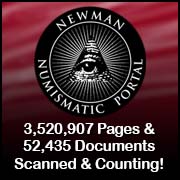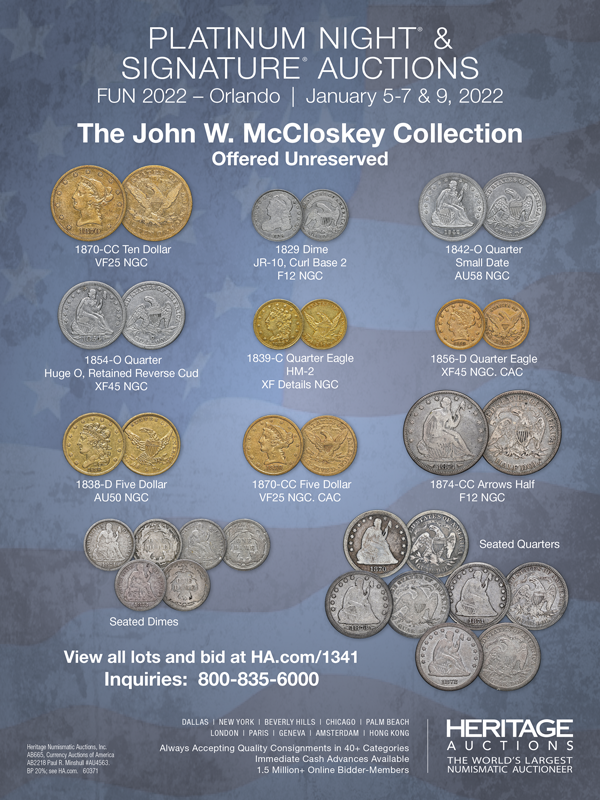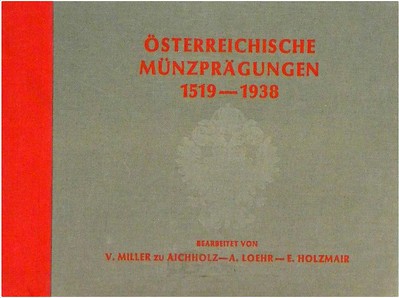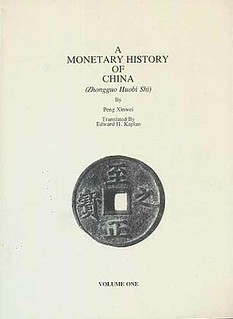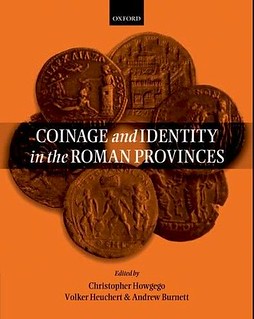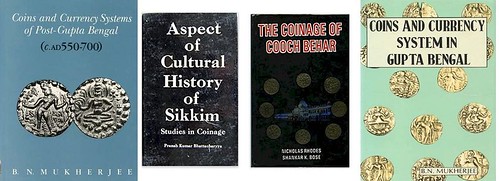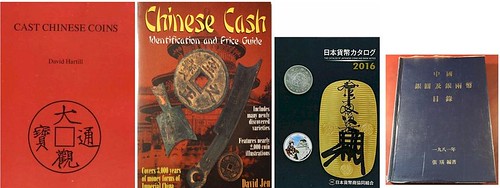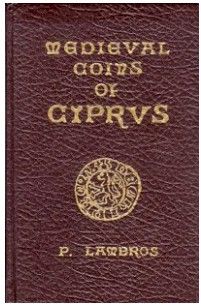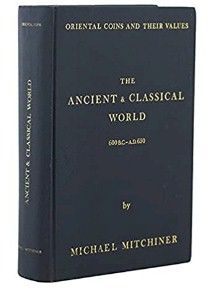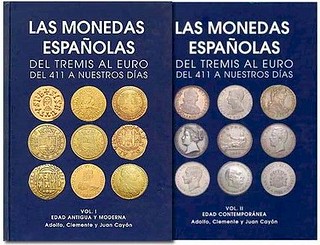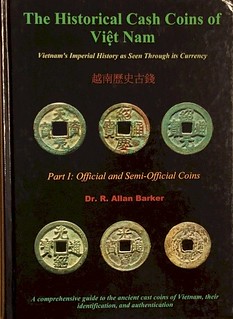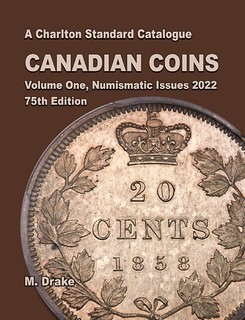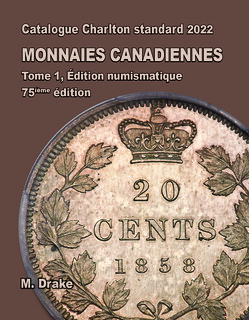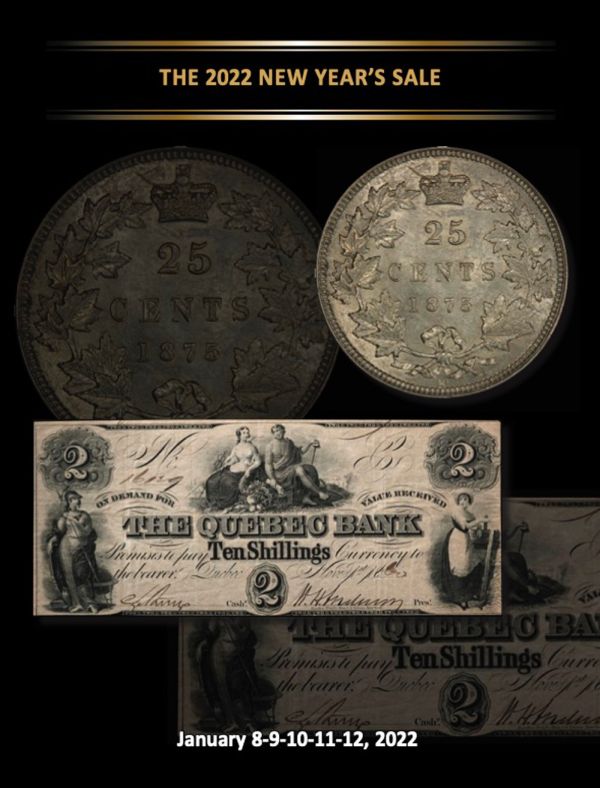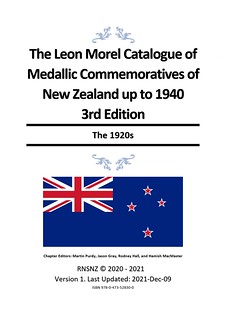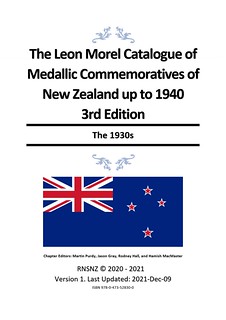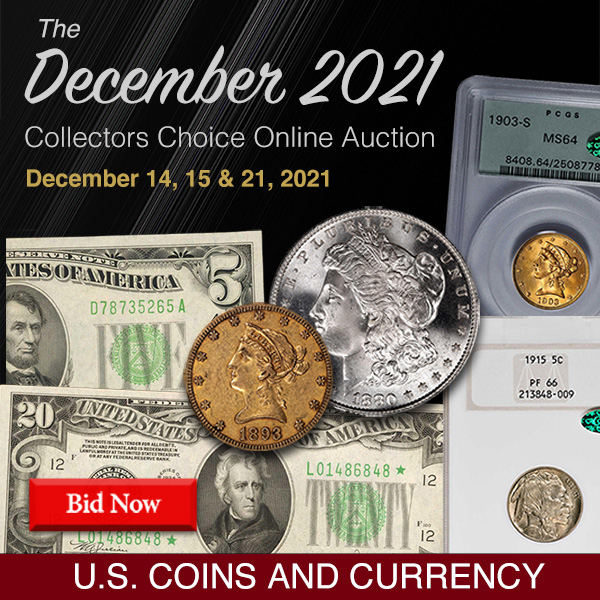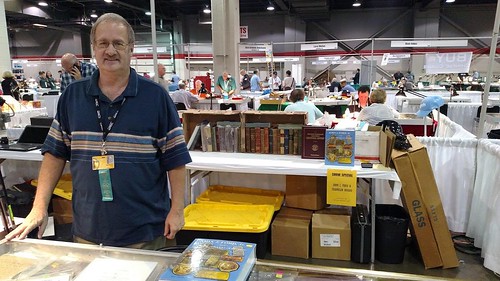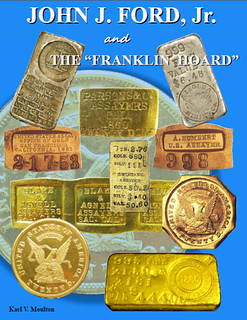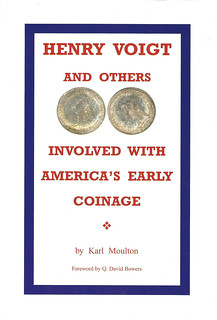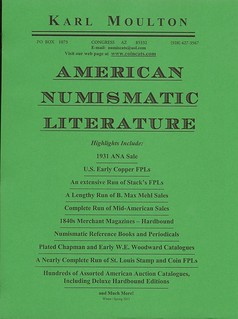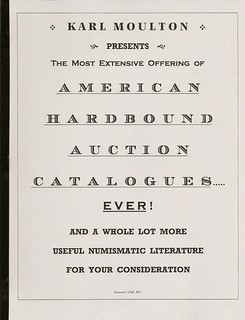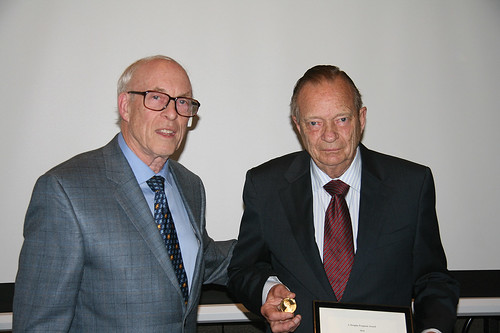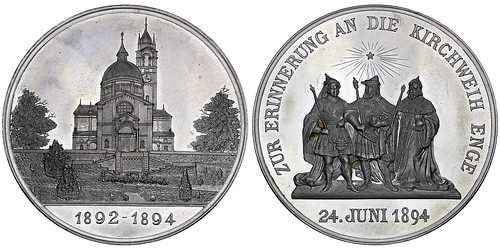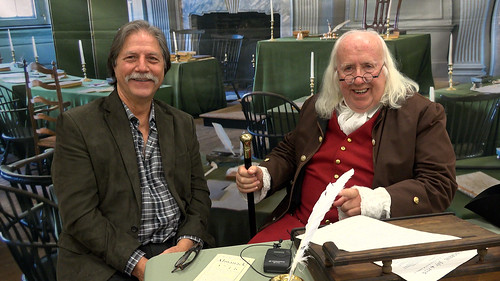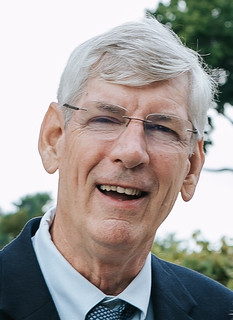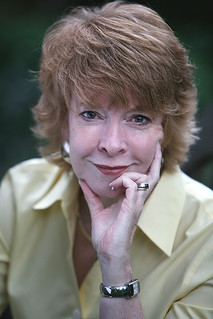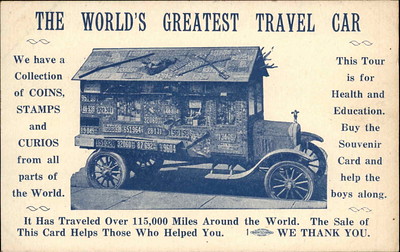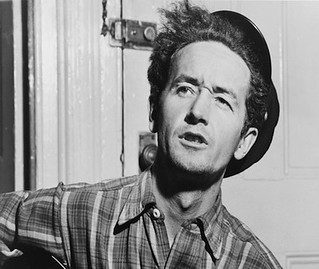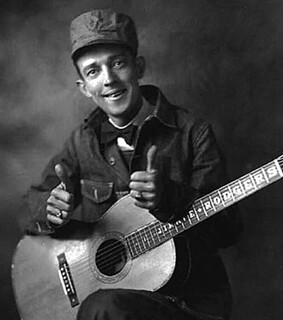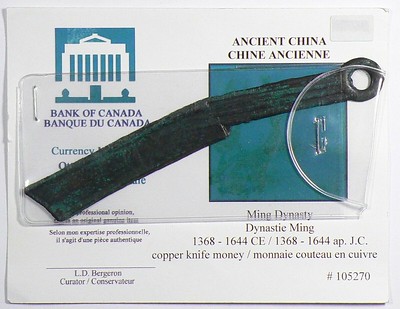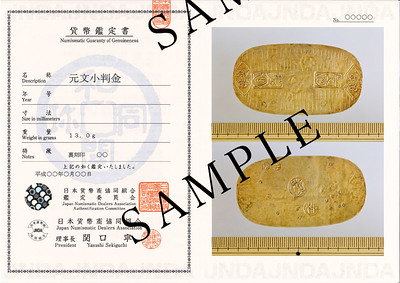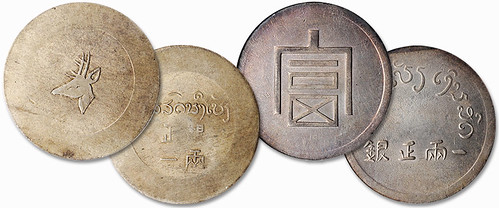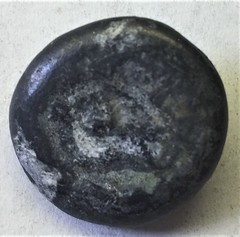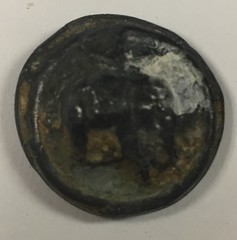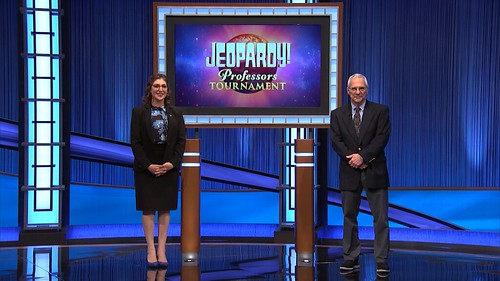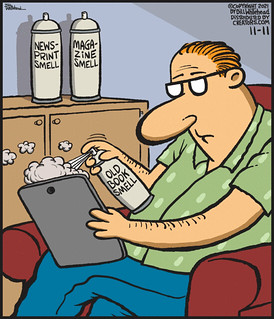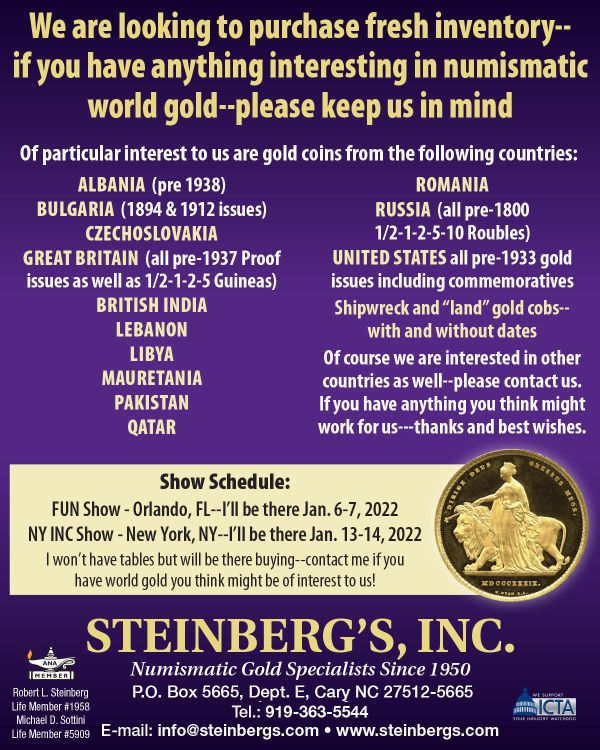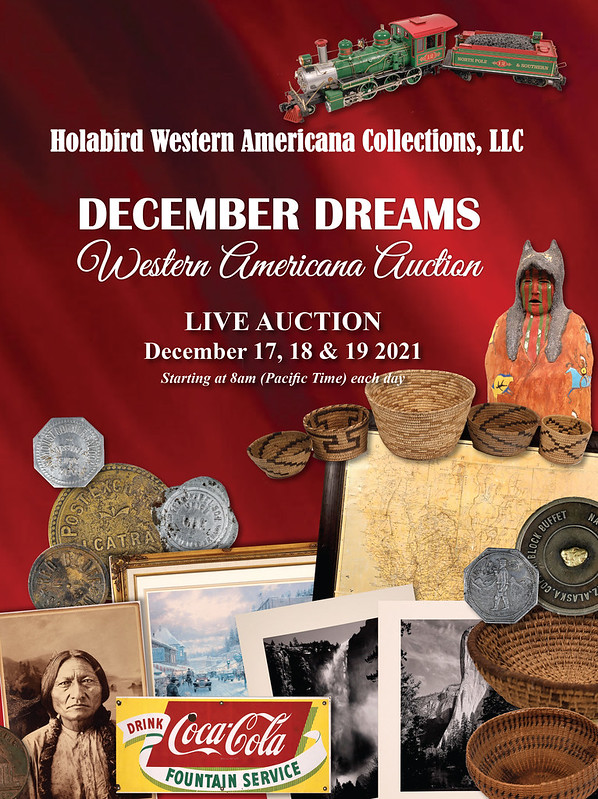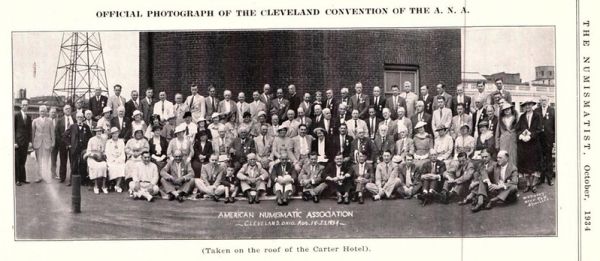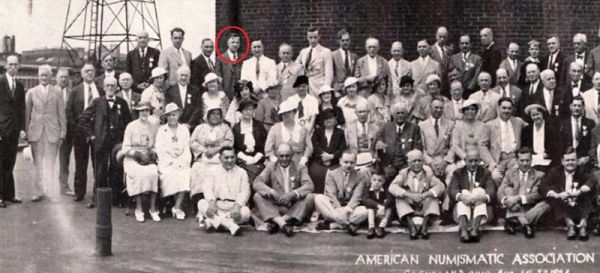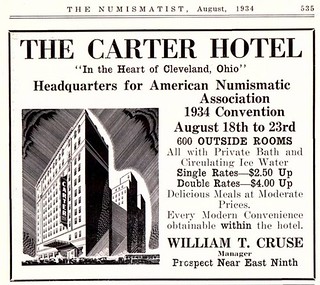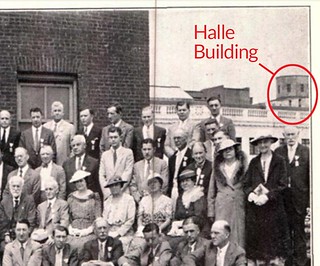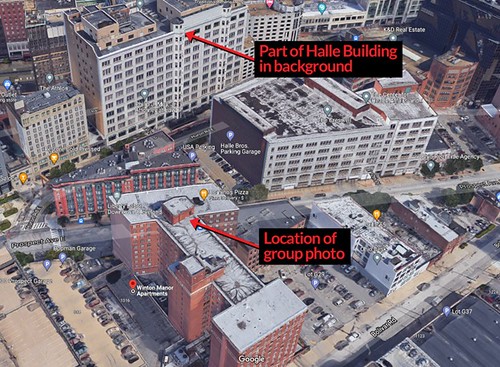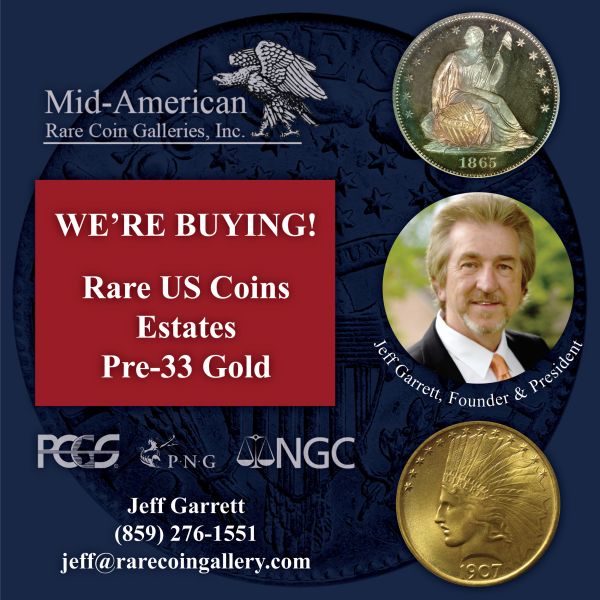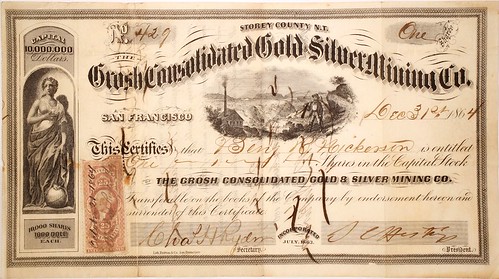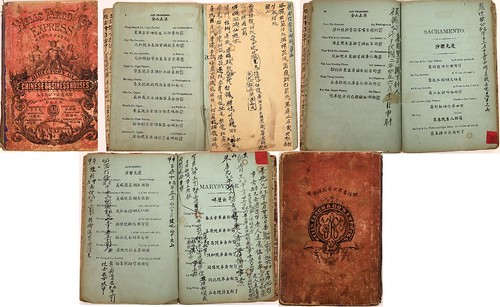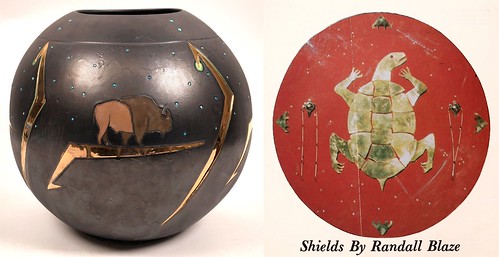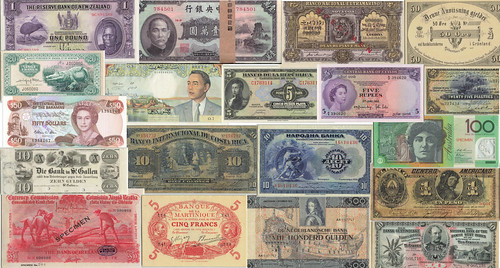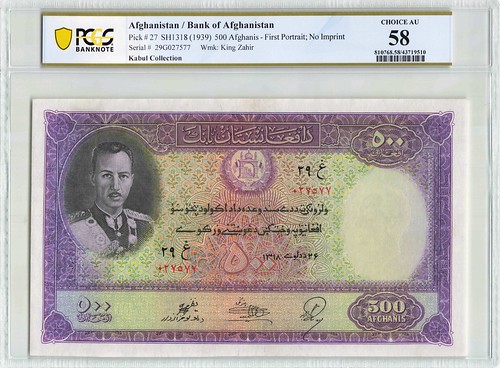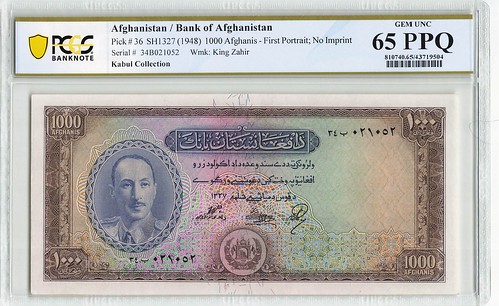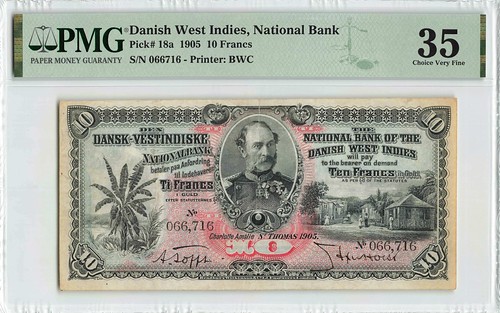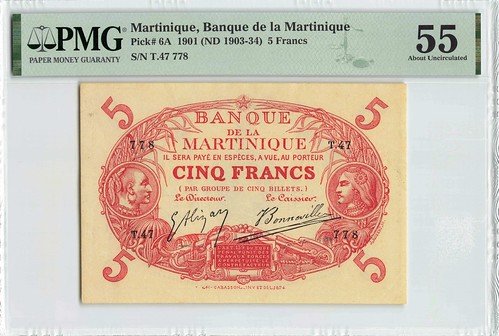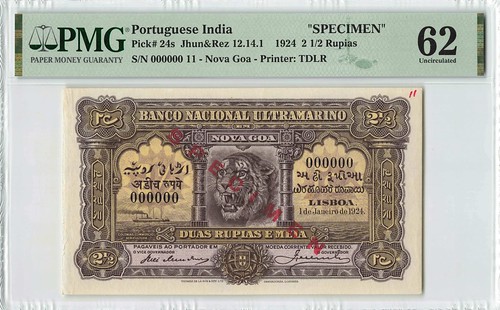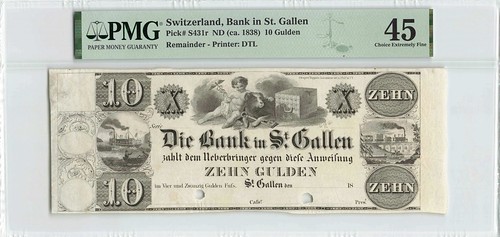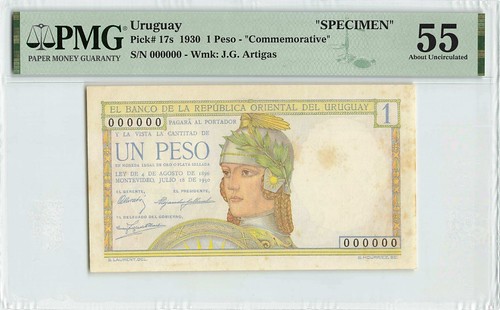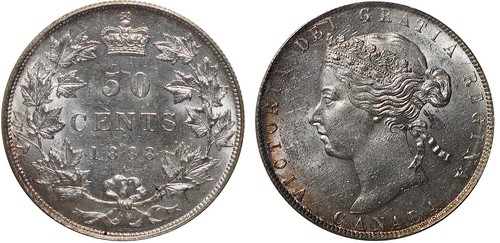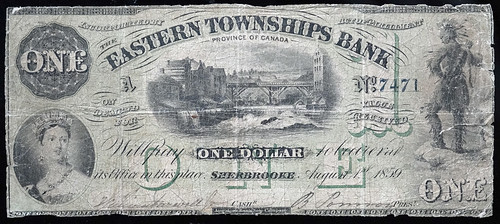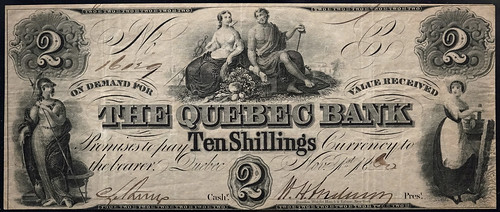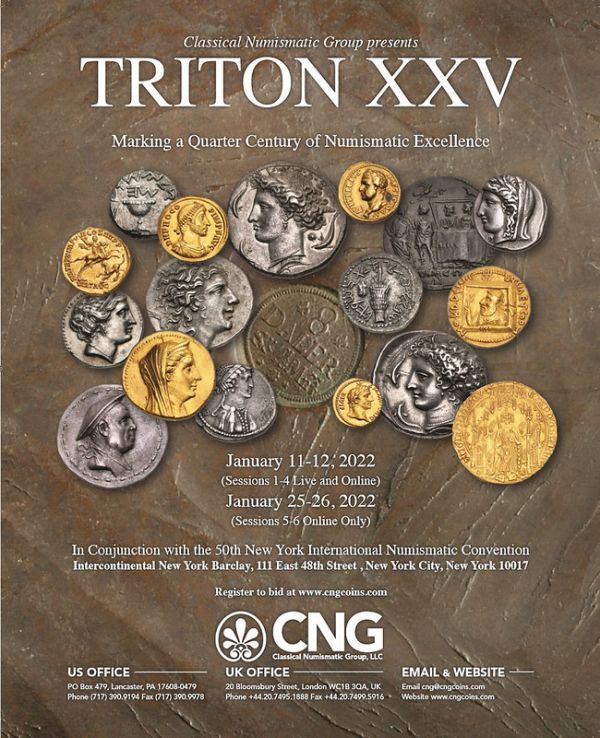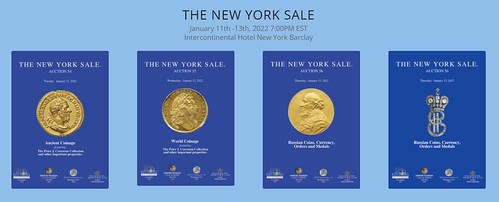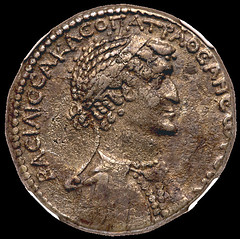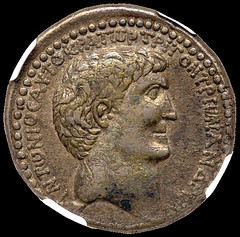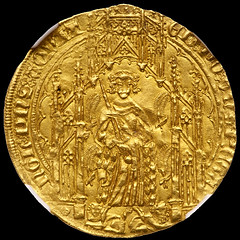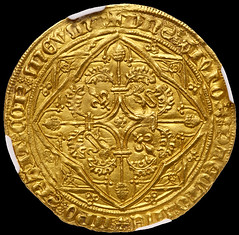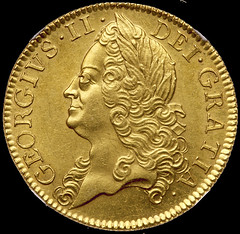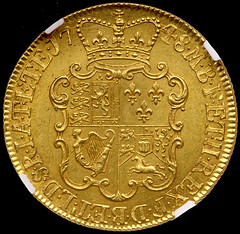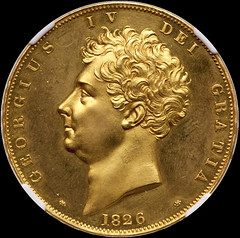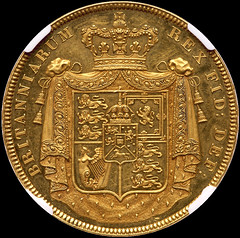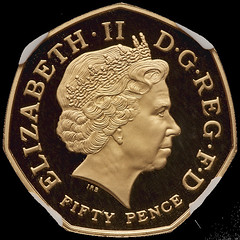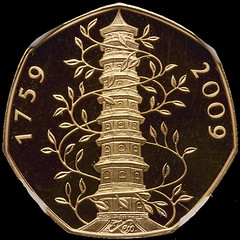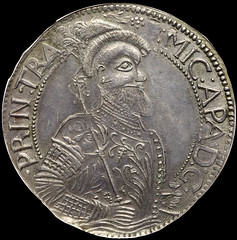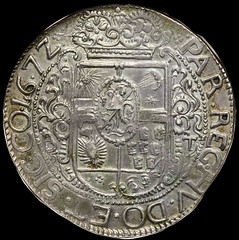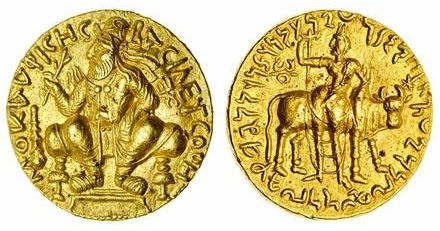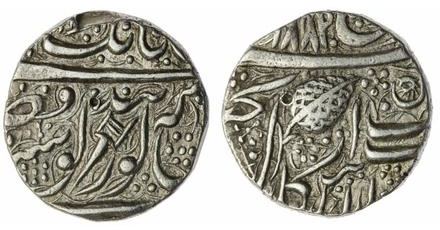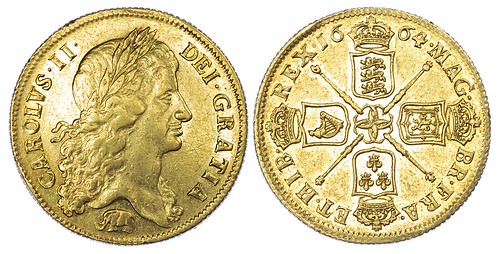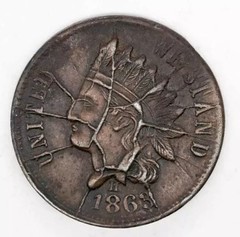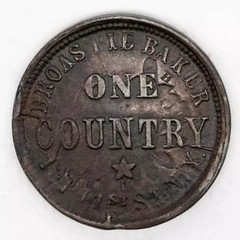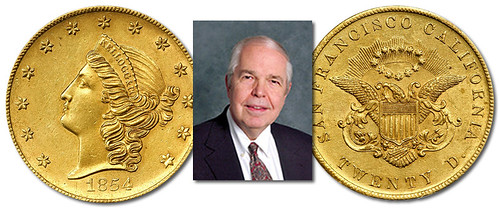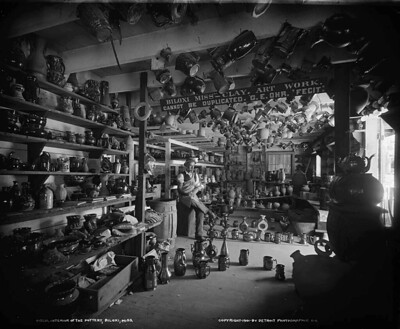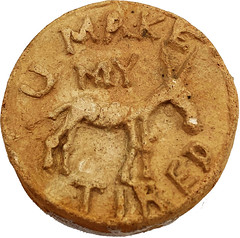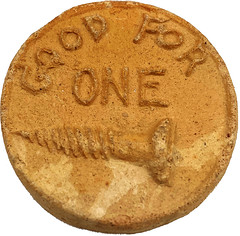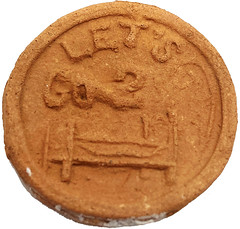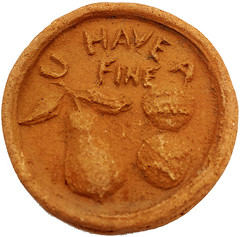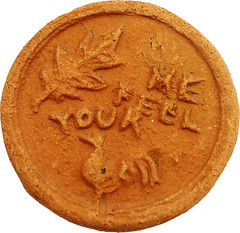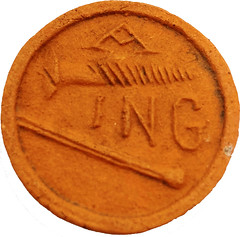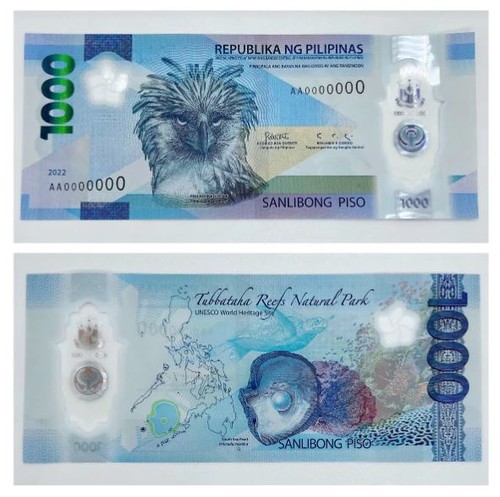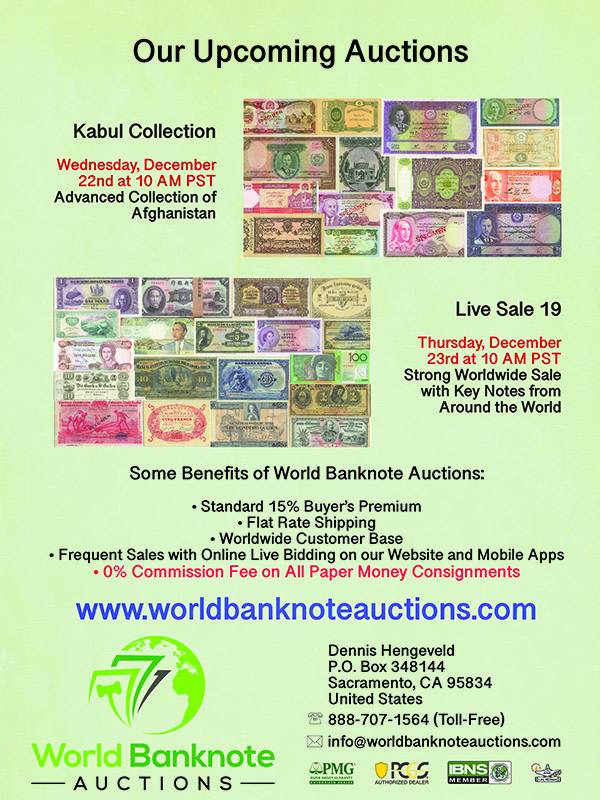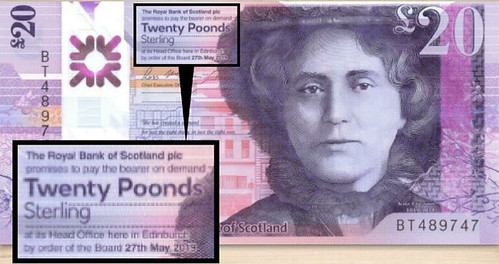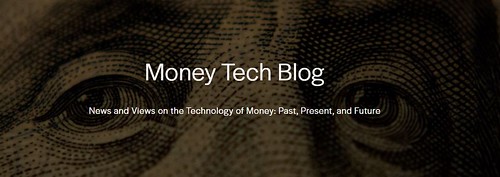
Visit our NBS Sponsors



About UsThe Numismatic Bibliomania Society is a non-profit association devoted to the study and enjoyment of numismatic literature. For more information please see our web site at coinbooks.org SubscriptionsThose wishing to become new E-Sylum subscribers (or wishing to Unsubscribe) can go to the following web page link MembershipThere is a membership application available on the web site Membership Application To join, print the application and return it with your check to the address printed on the application. Print/Digital membership is $40 to addresses in the U.S., and $60 elsewhere. A digital-only membership is available for $25. For those without web access, write to: Charles Heck, Treasurer AsylumFor Asylum mailing address changes and other membership questions, contact Chuck at this email address: treasurer@coinbooks.org SubmissionsTo submit items for publication in The E-Sylum, write to the Editor at this address: whomren@gmail.com BUY THE BOOK BEFORE THE COINSale CalendarWatch here for updates! |
- WAYNE'S WORDS: THE E-SYLUM DECEMBER 12, 2021
- TCNC JANUARY 2020 LITERATURE SALE
- NEW BOOK: CHARLETON CANADIAN COINS 75TH ED.
- NEW CHAPTERS: NEW ZEALAND MEDALS 1920S-30S
- KARL V. MOULTON (1953-2021)
- JAMES W. ASTWOOD (1934-2021)
- SWITZERLAND THREE KINGS MEDAL ON NNP
- VIDEO: DAVID LISOT INTERVIEWED BY BEN FRANKLIN
- BARBARA J. GREGORY NAMED CENTINEL EDITOR
- TROUBADOURS OF THE TRAVEL CAR COIN MUSEUM
- MORE ON KNIFE MONEY CERTIFICATION
- NOTES FROM E-SYLUM READERS: DECEMBER 12, 2021
- VOCABULARY TERM: GOLD MEDAL
- MORE ABOUT ROBERT H. LLOYD
- A.N.A. 75-YEAR MEMBERS
- FIVE QUESTIONS WITH KENNY SAMMUT
- HOLABIRD DECEMBER 2021 SALE
- WORLD BANKNOTE AUCTIONS LIVE SALE 19
- CANADIAN NUMISMATIC CO. JANUARY 2022 SALE
- 2022 NYINC SALE HIGHLIGHTS
- NUMISMATIC NUGGETS: DECEMBER 12, 2021
- KELLOGG AND CO. $20 COIN HOARD
- GEORGE OHR'S PROVOCATIVE CLAY TOKENS
- FRANCES OUTERBRIDGE SUFFRAGETTE MEDAL
- PHILIPPINE 1000 PISO NOTE CORRECTED
- FAKE SCOTLAND TWENTY ‘POOND' NOTE
- A BECHTLER HERITAGE CENTER CHRISTMAS
- FEATURED WEB SITE: MONEY TECH BLOG
Click here to read the thin version on the web
Click here to subscribe
Click here to access the complete archive
To comment or submit articles, reply to whomren@gmail.com
Content presented in The E-Sylum is not necessarily researched or independently fact-checked, and views expressed do not necessarily represent those of the Numismatic Bibliomania Society.
WAYNE'S WORDS: THE E-SYLUM DECEMBER 12, 2021
 New subscribers this week include:
Ron Dayton.
Welcome aboard! We now have 6,720 subscribers.
New subscribers this week include:
Ron Dayton.
Welcome aboard! We now have 6,720 subscribers.
Thank you for reading The E-Sylum. If you enjoy it, please send me the email addresses of friends you think may enjoy it as well and I'll send them a subscription. Contact me at whomren@gmail.com anytime regarding your subscription, or questions, comments or suggestions about our content.
This week we open with a numismatic literature sale, two new books, two obituaries, updates from the Newman Numismatic Portal, and more.
Other topics this week include James Astwood, David Lisot, Barbara Gregory, Kenny Sammut, 75-Year ANA members, the Travel Car troubadours, knife money, more auction previews, a suffragette medal, bad counterfeits, and George Ohr's racy clay tokens.
To learn more about Bengal coinage, New Zealand medals, Karl Moulton, Sam Buttrey, The Centinel, old book smell, the 1934 ANA convention, the Payteller token, the Brenner National Arts Club plaque, a hoard of Kellogg and Co. $20 gold coins, the twenty poond note and American Yodeling, read on. Have a great week, everyone!
Wayne Homren
Editor, The E-Sylum
TCNC JANUARY 2020 LITERATURE SALE
The Canadian Numismatic Company of Quebec is holding a numismatic literature sale January 17, 2020. Here are some selections. -Editor
Lot 1776: Austrian Coinage
Literature; (MEDIEVAL AND MODERN NUMISMATICS) ÖSTERREICHISCHE MÜNZPRÄGUNGEN 1519-1938 - V. Miller zu Aichholz, V., A. Loehr and E. Holzmair. Chicago, Lot of 2 books two volumes.
Lot 1780: Monetary History of China
Literature; A Monetary History of China, Volumes One and Two (Zhongguo Huobi Shi). Lot of 2 books.
Lot 1788: Coinage in the Roman Provinces
Literature; Coinage and Identity in the Roman Provinces by Volker Heuchert & Andrew Burnett.
Lot 1781: Bengal Coinage
Literature; Aspect of Cultural History of Sikkam Studies in Coinage, The Coinage of Cooch Behar, Coins and Currency Systems of Post-Gupta Bengal (C. AD 550-700) & Coins and Currency System In Gupta Bengal. Lot of 4 books.
Lot 1784: Chinese and Japanese Coins
Literature; Cast Chinese Coins by David Hartill, he Catalog of Japanese Coins and Bank Notes 2016, 1981 Chinese Book of Silver Crowns by H. Chang & Chinese Cash: Identification and Price Guide. Lotof 4 books.
Lot 1792: Medieval Coins of Cyprus
Literature; Coins of the Medieval Kingdom of Cyprus by Paul Lambros.
Lot 1810: Oriental Coins & Their Values
Literature; Oriental Coins & Their Values : The Ancient and Classical World 600 B.C. - A.D. 650 Hardcover – January 1, 1978 by Michael Mitchiner.
Lot 1820: Las Monedas Españolas
Literature; Spain - Las Monedas Españolas del Tremis al Euro del 411 a Neustros Días. Vol. 1 & II by Adolfo, Clemente Cayón and Juan Cayón. Madrid: Cayón-Jano S.A., 2005. Near new.
Lot 1829: Cash Coins of Vietnam
The Historical Cash Coins of Vietnam Part I: Official and Semi-Official Coins, Singapore, 2004, 407 pages, hardcover by Allan Barker.
To see the complete sale online, see:
https://auctions.canadiancoinsandpapermoney.com/auction/190/special-monday-night-auction-57-literature--rcm

NEW BOOK: CHARLETON CANADIAN COINS 75TH ED.
The new 2022 Charleton Canadian Coins book is available now in both English and French versions. -Editor
2022 Canadian Coins Volume 1
$29.95
First published in 1952 the Charlton Standard Catalogue of Canadian Coins has reported on all aspects of the Canadian numismatic scene, from the coinage of the French Regime to the business strikes of today. For more than 65 years Canadian Coins has been the bible for collectors. With this new edition, prices have been updated to reflect current selling prices in the market place. We have added several new varieties and have included many more images for the collector.
AVAILABLE IN ENGLISH OR FRENCH
75th Edition Author: M. Drake
For more information, or to order, see:
2022 Canadian Coins Volume 1
(https://coinstampsupplies.com/product/2022-canadian-coins-volume-1/)
NEW CHAPTERS: NEW ZEALAND MEDALS 1920S-30S
Two more digital chapters have been released in the progressive update to Leon Morel's catalogue of NZ Commemorative Medals prior to 1940. Thanks to Martin Purdy of Upper Hutt, New Zealand for passing this information along. -Editor
This is part of a projected multi-volume series updating Leon Morel's Catalogue of Medallic Commemoratives of New Zealand, 1865-1940 (1996) and the Supplement published in 2000. The third edition marks a departure from previous RNSNZ catalogue projects in that it is being released electronically in the first instance, and in sections. In this way, parts of the book can be published as they become ready, and can also be regularly updated as new information becomes available.
The various sections of the catalogue will ultimately cover the whole of NZ's medallic history from the
earliest issues associated with this country through to the Centennial events of 1940. More recent
issues, from 1940 (not Centennial-related) to date, are being covered by a companion series, New
Zealand Commemorative Medals since 1940, 3rd edition
, also being published in parts and in
electronic form.
Because these publications are being released as searchable PDFs, the previous Index of Legends has now been dispensed with as unnecessary.
To access the chapters online, see:
https://www.rnsnz.org.nz/collector-info/catalogues
To read the earlier E-Sylum article, see:
NEW BOOK: NEW ZEALAND MEDALS 1939-40
(https://www.coinbooks.org/v23/esylum_v23n36a05.html)
KARL V. MOULTON (1953-2021)
Steve M. Tompkins passed along this news about numismatic literature dealer and author Karl Moulton of Tombstone, AZ. -Editor
It is my sad duty to inform both the numismatic literature and coin collecting communities of the recent passing of former numismatic literature dealer, author and my friend Karl Moulton, on or about December 1st. He leaves behind one older brother who resides in Texas.
Karl was currently living in Arizona and working on a new book concentrating on the 1849 date of United States coinage. Sadly, that work will not be completed and is now lost to future numismatists.
Karl worked behind my table at the most recent ANA convention in Chicago this past August and had planned to attend the upcoming Spring ANA show next March in Colorado Springs.
Karl and I had been friends for almost 20 years, working both on projects of mine and I on projects of his. We attended many coin shows together, both as collectors and occasionally behind a table. We spoke weekly, with it a rare occurrence that the conversation would not amble on for an hour or more, 90% of which was about coins or history and life itself.
He was well versed in both early American history and the early Mint, with some of his theories as to what, when, why & how things came to be created at the Mint being sometimes controversial. But his knowledge was vast in the venue of United States numismatic auction history, with many catalogers and researchers frequently turning to him, seeking that knowledge for their work. Karl was happy to give freely that knowledge, to add to the greater achievement of advancing numismatics itself.
I will forever miss my friend and the in-depth conversations we had…
Such sad news to hear. It seems it wasn't all that long ago that I spoke with him at a pre-pandemic coin show. I somehow missed running into him at the recent ANA. -Editor
Joel Orosz writes:
"Karl Moulton was a true lover of numismatic literature, as a dealer in that trade must truly be. Any bookseller needs a first-rate mind to ply his trade, and to have a body capable of lugging an enormous amount of weight to and fro at every setup and breakdown. You have to love the trade, for the labor involved is just too onerous if you don't.
"Karl did love the literature, and was fortunate in his affections in that he loved paper catalogs more than hardcover books, and he loved the slim catalogs of the 19th century most of all. A literature dealer could carry a score of such catalogs in the space and for the weight that a single recent hardcover would occupy. If a collector needed a particular copy of a John Haseltine sale, or a specific public auction by Lyman Low, Great American Sales would likely have a copy handy in stock. Karl's name was never associated with the sale of a great numismatic literature collection, but many were the scholars and writers he helped find just the needed missing piece of the research puzzle. Q. David Bowers was one such beneficiary, and a long list of others could be named.
"Of course, Karl was responsible for a couple of damned thick, square books
himself, a two-volume reprint of Joseph Mickley's business journal, and Karl's original research on John J. Ford and the Franklin hoard. Future booksellers will remember him every time they haul these tomes out to a show.
"Coincidences abound, of course, yet some seem uncanny in their occurrence. In the October 26, 2021 edition of Numismatic News, Bob Van Ryzin wrote about a wampum belt that the Lenni Lenape tribe had presented to William Penn in 1682. I wrote a letter to the editor, with a picture of the belt, taken from a seven panel fold-out color lithograph in a book in my library, Memoirs of the Historical Society of Pennsylvania Vol. VI (1858). This letter and its accompanying photograph was published in Numismatic News' November 30, 2021 edition. This book happened to be the last item I ever purchased from Karl. It's a loss for us all that there won't be any more."
Len Augsburger writes:
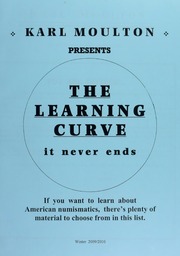 "So sorry to hear this. Karl greatly appreciated numismatic literature and served as a market maker, especially for lower-priced items. I recall swapping
"So sorry to hear this. Karl greatly appreciated numismatic literature and served as a market maker, especially for lower-priced items. I recall swapping Bowersiana
(publications of Bowers & Ruddy, later Bowers & Merena) with him early in my collecting career. Some time ago he granted permission to archive his fixed price lists on Newman Portal, and these were promptly scanned for posterity. His magnum opus, John J. Ford, Jr. and the Franklin Hoard
stands as a massive compendium of original documents related to false western gold pieces and remains an important reference on the topic."
Link to Karl Moulton fixed price lists on Newman Portal:
https://nnp.wustl.edu/library/publisherdetail/512907
Comments about Karl on the Collectors Universe Forum, see:
https://forums.collectors.com/discussion/1067860/karl-moulton-rip#latest
Dave Hirt writes:
"Karl was a giant of numismatic literature. Few people could have done all the research that was needed to write the book, John J. Ford and the Franklin Hoard. I am glad to own a copy of that book.
"Also, Karl did an invaluable service to numismatic 19th century auction catalog collectors when he organized a survey of those catalogs, published in The Asylum Winter, 2005 issue. I do not think that I have ever seen that issue for sale. I refer to mine often, and if the catalogs sold in the recent Fanning sale of the Scott Rubin collection are added, you can get a very good idea of the population of rare auction catalogs."
P. Scott Rubin writes:
"I was very sad to hear of the passing of Karl, he did so much on his own to promote numismatic auction catalogues and obscure Fixed Price Lists. He also used these items to do some very important original research. I, like Dave Hirt, used his survey of 19th century auction catalogues as a check list for what existed. I have not heard from Karl in a few years and always missed receiving the listing of what he had for sale and over the years purchased a number of items from him. While all his research was not used by mainstream numismatic collectors and some of it, in my opinion needed some refinement, overall numismatics as a hobby benefited from his works. I will miss reading whatever numismatic topics he was working on at the time of death. I am sure I would have found it interesting."
David Fanning writes:
"This is another sad surprise. I agree with Dave Hirt that his census is a useful starting point when discussing rarity of catalogues. I didn't know him particularly well, but he was always pleasant to deal with."
To read earlier E-Sylum articles, see:
KARL MOULTON OFFERS NEW FIXED PRICE LIST
(https://www.coinbooks.org/esylum_v19n05a02.html)
BOOK REVIEW: JOHN J. FORD AND THE FRANKLIN HOARD
(https://www.coinbooks.org/esylum_v16n26a07.html)
BOOK REVIEW: JOHN J. FORD AND THE FRANKLIN HOARD
(https://www.coinbooks.org/esylum_v16n28a06.html)
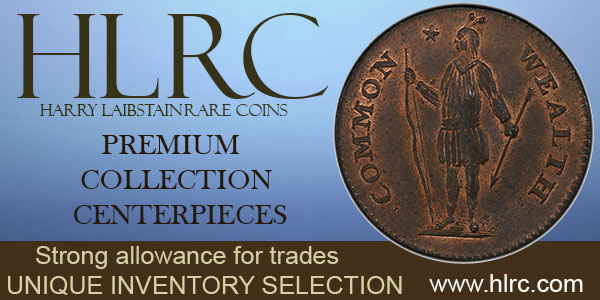
JAMES W. ASTWOOD (1934-2021)
Howard R. Engel of Richard Stockley Books in Winnipeg, Manitoba, Canada passed along this note about author J.W. Astwood from Jim Bailie (also of Winnipeg):
"Jim passed away on December 4, 2021. He was a giant of numismatics. Jim received the prestigious J. Douglas Ferguson Award at the RCNA convention in Toronto in 2014. He set a standard for writing tokens books."
The J. Douglas Ferguson Award is the highest award in Canadian numismatics and is given annually to the living numismatist who, in the opinion of the Board, has contributed most to the advancement of numismatics in Canada, through research, writing or publishing, or in any other manner, who has not previously received the award.
Jim also passed along the above image from the Royal Canadian Numismatic Association website. Howard added the following observations. Thank you both! Sorry to hear the news. -Editor
I'm shocked and saddened by this news. I know people in the numismatic community across Canada and beyond who also knew and appreciated "Mr. Astwood" as we all knew him (although in his informal and friendly way he always referred to himself as "Jim"), and his many contributions to the hobby, particularly on Manitoba trade tokens. Like you said, Mr. Astwood is a numismatic giant and will leave a huge hole in our community across Canada and especially in his native Manitoba. He was active to the end. The latest issue of Numismatica Canada (vol. 20 no. 4, Dec. 2021, issue no. 80) included the following classified ads from him:
Wanted for my personal collection: Breton 735 and 736 (Illiffe tokens) all varieties. Jim Astwood - jastwood@mymts.net, and For those interested in an updated supplement (January 2020) for the An Illustrated Guide To Manitoba Trade Tokens please contact Jim Astwood - jastwood@mymts.net
His latest articles in that venerable publication (from vol. 20 no. 2, June 2021, issue no. 78) were:
Marius Cinq-Mars A Scholarly Manitoban.............................Jim Astwood, FCNRS............60
Bank Hotel...............................................................................Jim Astwood, FCNRS............63
Among his many published articles over the years, one of the most memorable and practical was his "Fur Trade Tokens-- Fakes, Fantasies and Copies" published in the Canadian Numismatic Journal, vol. 61 no. 5, July-August 2016, p. 214-217.
Of course, perhaps his biggest claim to fame was his ongoing labour of love and tour de force, An Illustrated Guide to Manitoba Trade Tokens, most recently published in its 10th edition (2018), plus the Jan. 2020 supplement. As you will recall, Mr. Astwood took over where the late, great Donald M. Stewart left off with A Complete Supplement to Trade and Advertising Tokens of Manitoba (1979), a decade after the original work was published by The Canadian Numismatic Research Society in 1969. It remains to be seen if and how this important work may continue in Mr. Astwood's absence.
I know you and Mr. Astwood had an extra special friendship. I appreciate how you often bore eloquent witness to that friendship marked with so much kindness and generosity in the stories you have shared with me over the years. He was a true gentleman and scholar who contributed so much to the hobby for many decades. I'm most grateful to you that you were able to present Mr. Astwood with his 65th anniversary membership (no. 1048) certificate in the Royal Canadian Numismatic Association. He was also the last surviving charter member of the Manitoba Coin Club, serving as its first Treasurer and then as Secretary in 1957. I'm also very grateful to Judy Blackman the editor of the Manitoba Coin Club's official newsletter, Bison Tales, for publishing Mr. Astwood's reminiscences as a Manitoba Coin Club charter member in the October 2020 issue, p. 6-9.
For more on the 2014 RCNA convention, see:
2014 Toronto RCNA Convention :
Non-RCNA Awards 2014
(https://www.rcna.ca/2014/awards.php)
Here's an excerpt from Astwood's online obituary. -Editor
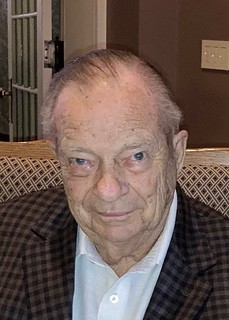 With his loving wife and children at his bedside, James (Jim) Astwood passed away at Health Sciences Centre, Winnipeg, Manitoba at the age of 87.
With his loving wife and children at his bedside, James (Jim) Astwood passed away at Health Sciences Centre, Winnipeg, Manitoba at the age of 87.
Jim Astwood was born in the winter of 1934 in Winnipeg in the house that his father, James Clifton Astwood, and mother, Dorothy Helen Astwood (nee Martin), had built on Rosedale Avenue in Riverview.
After attending Kelvin High School, Jim followed in his father's footsteps and entered the accounting profession as an auditor. He was with Price Waterhouse and travelled throughout Canada, working primarily out of offices in Toronto and Montreal. In 1957 he became a Chartered Accountant.
Returning to Winnipeg, he met the love of his life, Margaret Lynne Astwood (nee Bateman), at the Winnipeg Canoe Club in St. Vital – they married in 1961. The Canoe Club became the center of his family life, where Jim, Margaret and their three children, Robert, Marilyn and James spent countless happy hours together and with many family friends. The Canoe Club was one of his great passions, serving as Commodore in 1963 and later helping the Club transition to a public golf course.
Jim was also generous with his time and energy in the community. He served for many years on the board of the Manitoba Opera, and as President from 1995-97, and contributed time and energy to numerous other foundations and charitable organizations. In recent years, he re-discovered his passion for Snooker, and was often seen calculating (and perhaps gambling with a bit of a grin) his next shot. Jim also had a passion for studying Manitoba and Western Canadian History – especially the Hudson's Bay Company period from 1670 through 1874. He enjoyed all things Winnipeg
and was last seen reading the Winnipeg Free Press' assessment of the Blue Bomber's chances in the 2021 CFL Western Final.
To read the complete article, see:
James William Astwood
(https://www.dignitymemorial.com/obituaries/winnipeg-mb/james-astwood-10474397)

SWITZERLAND THREE KINGS MEDAL ON NNP
The latest addition to the Newman Numismatic Portal is Jeremy Bostwick's latest Numismagram pricelist. Project Coordinator Len Augsburger provided the following report. -Editor
Among the dealer fixed price lists archived on Newman Portal is Jeremy Bostwick's Numismagram, a periodic presentation of historical and art medals. To my knowledge, these lists have appeared in e-periodical format only and have not been published as hardcopies. Newman Portal preserves born-digital material such as Numismagram in addition to scanning hardcopies of other publications. A recent Numismagram issue for December 2021 (#70) featured an 1894 Swiss medal presenting the three magi.
Bostwick's description notes Presenting the iconography of the Three Kings on the reverse, this medal has a festive holiday feel even though it celebrates the opening of the new church in Zürich, which took place in the summer of 1894. Nevertheless, the Three Kings (or Magi), guided by the Star of Bethlehem (or Christmas Star), are associated heavily with the Christ tradition, bearing the gifts of gold (representing earthly kingship), frankincense (representing the divine), and myrrh (representing the end of life). Three Kings' Day, also known as Epiphany, is traditionally celebrated on 6 January, which corresponds to the twelth day of the mass of Christ, and the day on which the Three Kings are to have arrived to bear their gifts to the Christ child.
Link to Numismagram on Newman Portal:
https://nnp.wustl.edu/library/publisherdetail/537693

VIDEO: DAVID LISOT INTERVIEWED BY BEN FRANKLIN
These are selections from the David Lisot Video Library that feature news and personalities from the world of coin collecting. David has been attending coin conventions since 1972 and began videotaping in 1985. The Newman Numismatic Portal now lists all David's videos on their website at:
https://nnp.wustl.edu/library/multimediadetail/522852
Here's a real table-turner - David becomes the interviewee. -Editor
David Lisot Interviewed by Ben Franklin
at the Pennsylvania Association of Numismatists Convention 2021.
VIDEO: 16:09.
Patrick McBride, Ben Franklin, Pennsylvania Association of Numismatists, David Lisot, CoinTelevision.com. October 29, 2021.
Imagine being interviewed by Benjamin Franklin! Entrepreneur and veteran coin reporter for CoinTelevision.com. David Lisot had just that opportunity at the Pennsylvania Association of Numismatists on October 29, 2021. Mr. Franklin asks David about his extraordinary experience videotaping the numismatic hobby. He delves into the intricacy of David's s experiences and what were the most important aspects. If you want to see David Lisot who championed preserving the history of numismatics for more than 40 years on video then watch this interview!
An excerpt of the video is available for viewing on the Coin Television YouTube Channel at:
https://youtu.be/iQFaA0hl11g

BARBARA J. GREGORY NAMED CENTINEL EDITOR
Barbara Gregory will replace retiring Gerry Tebben as the editor of The Centinel. Here's the press release. -Editor
Barbara J. Gregory, the former Editor of The Numismatist, the monthly magazine of the American Numismatic Association, has been named Editor of The Centinel, the quarterly journal of the Central States Numismatic Society. She will succeed Gerald Tebben who is retiring this coming summer after 12 years as Editor of the award-winning CSNS publication.
"When Gerry informed me of his desire to retire, the first name that came to my mind was that of Barbara Gregory. I was so pleased when I contacted her and she said she was interested in the position with CSNS, recalled CSNS President Mitch Ernst.
Gerry has become a dear friend during my tenure as President, and I have appreciated his opinions and perspectives. He will be missed, but we also are excited to see what Barbara will bring to our organization and our membership through the pages of The Centinel," said Ernst.
Gregory retired in April 2019 as Editor-in-Chief of The Numismatist after 38 years with the ANA. She was the first female editor of the publication and served as its editor-in-chief for 32 years starting in 1988. During her tenure at the ANA, The Numismatist became the first major hobby periodical to switch to desktop publishing and printing every edition in full color. She also worked to provide online access of the magazine to ANA.
Under her skillful leadership, the publication has won dozens of awards from the Numismatic Literary Guild and received accolades from the collector community.
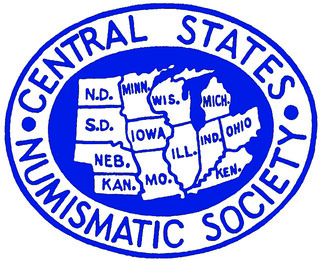
I look forward to working with the Central States Numismatic Society and carrying on the tradition of excellence established by its members, patrons, and officers, most notably Centinel Editor Gerald Tebben. Thanks to Gerry's vision and guidance, the CSNS quarterly journal has become a highly regarded, award-winning publication,
said Gregory.
She added: I see The Centinel as the heart of this grassroots collector community. It highlights the interests, challenges. and strengths of its members, and supports the needs of this vibrant numismatic region. In the months to come, The Centinel will be reimagined and rejuvenated, with a lively new format and the informative news and articles members have come to expect. This transformation is an evolutionary process. As such, I appreciate readers' patience, as well as their comments and suggestions.
Tebben served as a reporter, coin columnist, Business Editor and Metro Editor during a 40-year career at The Columbus Dispatch newspaper in Ohio.
I became Editor of The Centinel in late 2009 on the death of Rollie Finner. I was blessed with editorial contributions from established writers such as R.W. Julian, Steve Roach, and David Vagi, and engaged new authors. I also strived for content about the Central States region, increasingly picking up articles from Central States member club newsletters and providing a wider audience to local writers such as Milwaukee's Tom Casper and Elgin's Jim Davis,
said Tebben.
While I am cutting back, I plan to continue as a columnist and values analyst for Coin World and as a member of the Ohio state management team for AARP Foundation's all-volunteer Tax-Aide program, which provides free tax preparation for senior citizens across the country,
he added.
Founded in 1939, the Central States Numismatic Society is one of the largest numismatic organizations in the United States. The society operates in 13 states, but membership is open to residents of all states and foreign countries. States in the CSNS region are Illinois, Indiana, Iowa, Kansas, Kentucky, Michigan, Minnesota, Missouri, Nebraska, North Dakota, Ohio, South Dakota, and Wisconsin.
For additional information about the Central States Numismatic Society and its annual convention conducted in the Chicago suburb of Schaumburg, Illinois each April, visit http://www.centralstatesnumismaticsociety.org/ .


TROUBADOURS OF THE TRAVEL CAR COIN MUSEUM
Reader Ron Haller-Williams is quick with his research on E-Sylum topics, but it can take a while for me to pull his findings together for another issue. Here's a distillation of some of his discoveries relating to the post-WWI coin-covered "Travel Car" Carol Bastable discovered pictured on a postcard last month. But it's worth the wait, for Ron can dig up information from the most obscure areas of the internet, such as this passage translated from a German-language webpage on the history of Country Music. Ron bolded some phrases that seem to reference the "travel car". -Editor
... the official starting signal for the music style "Country Music" fell with a handful of recordings on August 1, 1927, given by a certain James Charles Rodgers, commonly known as Jimmie Rodgers, who also recorded one of his famous "Blue Yodels", namely "Blue Yodel #1 – T For Texas".
Back to Jimmie Rodgers: Together with two musician friends, Lucien "Piggy" Parks and Goebel Reeves, the still unknown "Singing Brakeman" drove across the States in a Ford Model T and toured. Long before 1927, this tour happened and Jimmie Rodgers made the best use of the trick he learned from Goebel Reeves, eventually making it known and becoming famous as a result: American Yodeling. Goebel Reeves, who declared in one of his rare radio interviews "I made it a rule never to stay in one place longer than six months", logically travelled a lot, with America's entry into the First World War he even came as far as Europe. In Europe, he heard people yodelling for the first time, and he took that – in addition to a gunshot wound – back to the States. After finishing the tour with Rodgers and Parks, Reeves hired to get back to Europe. Somewhere in Italy, around 1928, just before returning home, he heard a familiar voice from a gramophone shop: Jimmie Rodgers, yodelling... Goebel Reeves' first reaction: "If Jimmie is successful with this, why not me?" Back in the U.S.A., he recorded dozens of songs that, with one exception ("Hobo's Lullaby", Woody Guthrie's later favorite song), didn't get a particularly big response...
Here are a couple more related citations. -Editor
"Goebel Leon Reeves (October 9, 1899 – January 26, 1959) ...
In 1917 he enlisted in the army as a bugler; he was wounded in frontline action. He was discharged and in 1921 adopted the life of a hobo, writing and singing songs as he travelled."
See:
Goebel Reeves
(https://en.wikipedia.org/wiki/Goebel_Reeves)
Biography
Goebel Reeves
(https://www.allmusic.com/artist/goebel-reeves-mn0000561576/biography)
Goebel Reeves Wiki, Biography, Age, Career, Relationship, Net Worth & Know About Everything
(https://wikitrusted.com/goebel-reeves-wikipedia/)
"He had a long musical career that began when he headed east with Jimmy Rogers and Lucian Piggy' Parks whom he met in New Orleans in the 1920's."
See:
Hobo's Lullaby
(https://musicfromthedepression.com/hobos-lullaby/)
And that, Dear Readers, is the long and winding path between coins and American Yodeling. Thanks! Very interesting connection to music history. It would still be nice to learn the fate of the Free Museum at Washington and whether the Travel Car and its coins have survived to this day. Great piece of American history. -Editor
Images from:
Jimmie Rodgers (country singer)
(https://en.wikipedia.org/wiki/Jimmie_Rodgers_(country_singer))
Goebel Reeves
(https://kutx.org/features/goebel-reeves/)
To read the earlier E-Sylum articles, see:
NOTES FROM E-SYLUM READERS: NOVEMBER 7, 2021 : The Travel Car Coin Museum
(https://www.coinbooks.org/v24/esylum_v24n45a13.html)
MORE ON THE TRAVEL CAR COIN MUSEUM
(https://www.coinbooks.org/v24/esylum_v24n46a11.html)
MORE ON KNIFE MONEY CERTIFICATION
John Madlon writes:
"The knife coin in last week's E-Sylum, that's not from the Ming Dynasty, it's Eastern Zhou (Warring States Period), cast by the State of Yan. These types of knives all have the character ming 明 on them, hence their name "ming knives." I'm surprised a museum would make such a basic error in attribution. See more examples of these on Zeno.
"I've never heard of that museum doing authentication. I know the British Museum does authentication. That card reminds me of a Japan Numismatic Dealers Association (JNDA) certificate or the old ANACS photo certificates."
See:
https://www.zeno.ru/showgallery.php?cat=18872
https://www.jnda.or.jp/wp-content/uploads/2019/03/kantei-sample.jpg
Ted Puls writes:
"The Chinese coin shown in the Bank of Canada certification service holder, I have not heard of, but maybe I don't get out much. The Ming Knife money displayed brought a chuckle in that the manufacture of an authentic Ming Knife would have been during the Zhou dynasty and were made in this style ca. 400-220 B.C. While the knife may be authentic, the attribution service is questionable."
Thanks, everyone. -Editor
To read the earlier E-Sylum article, see:
NOTES FROM E-SYLUM READERS: DECEMBER 5, 2021 : Query: Bank of Canada Currency Museum Certification
(https://www.coinbooks.org/v24/esylum_v24n49a09.html)
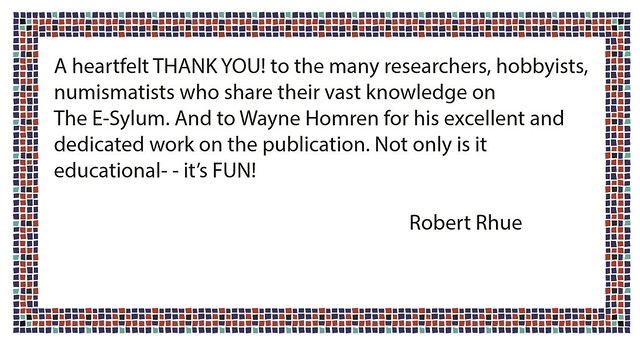
NOTES FROM E-SYLUM READERS: DECEMBER 12, 2021
Correction: "Emergency Chinese Money"
"The November 21 issue of The E-Sylum has an item; "A Tael of Emergency Chinese Money", which has several errors in it. I believe these pieces were first cataloged in Eduard Kann's Illustrated Catalog of Chinese Coins, and the writer of your item likely used it as his primary source. Eduard Kann was completely misinformed about these pieces being used to pay Chinese troops on the Burma front because he had been told the old Lao characters on the reverses were Burmese and they were from Yunnan.
These pieces were circulating in the French Protectorates of Laos and Tonkin, until the Chinese troops from Yunnan province were sent south by the United Nations to take the post-WWII Japanese surrender above the 16th parallel in French Indochina. When the Chinese returned to Yunnan, they were carrying the French Indochina opium
bullion coins, which they then sold to silver and goldsmiths, who eventually sold them into Hong Kong where many entered the numismatic marketplace. At that time, numismatists identified them as Yunnan-Burma pieces because of Kann's misidentification.
The first error in the item is the title because they are not emergency Chinese money. They were minted in Hanoi to assist the government in buying opium from the highland people in Tonkin and Laos, and not Yunnan province in China. The largest percentage of taxes for the French, and especially during WWII, was from the sale of opium and they badly needed silver coins
because the highland people did not accept banknotes.
Since they were not meant for anywhere outside of French Indochina, the ounce
and half ounce
pieces are in Vietnamese weights of about half (19 grams) or one lang or luong
(38 grams), and the reverses have the old Lao for half or one bheuy
pure silver. The Vietnamese used Chinese calligraphy but some were altered over time. The obverse of the first varieties had the Vietnamese character Phu, which did not have any changes from the Chinese Fu, for prosperity. Most of the highland people could not read or write so designs were more important to them. The second series changed the obverse character to a deer design. The first deer design did not satisfy the highland people so a second design was created for them.
My primary source about these pieces is Dr. Francois Thierry, who has since retired from the National Library of France. He has written detailed articles about these pieces and assisted me in my research. The old Lao was not correctly translated until Dr. Allan Barker's wife Soi assisted me. Soi's father was a linguist and taught her about the old Lao. I also did research in the current National Library of Viet Nam, which has many of the French Indochina WWII era newspapers and official documents. "
Thanks, Howard! -Editor
To read the earlier E-Sylum article, see:
A TAEL OF EMERGENCY CHINESE MONEY
(https://www.coinbooks.org/v24/esylum_v24n47a26.html)
More On Removing Published Material
Regarding George Kolbe's note about the removal of an image from an archived issue of The Numismatist,
Mel Wacks writes:
"Caricatures of Jews on Hobo nickels are clearly antisemitic, and the less we see of them the better."
Agreed. I thought the Numismatist editor's response was perfectly fine until the last sentence. George's comment was about the removal of the previously published image, and that bothers me, too. All of our E-Sylum issues are archived online as an historical record. We make mistakes all the time but don't go back and alter the record - we acknowledge the mistake in a following issue to correct the record and move on. -Editor
Mel adds:
"I am not one who wants to erase history. As a matter of fact, I picture many antisemitic medals on my website, such as the content of "ANTISEMITIC BIGOTRY ON HISTORIC MEDALS" by Dr. Benjamin Weiss. But it is not necessary to illustrate a generic article about Hobo nickels with an antisemitic example."
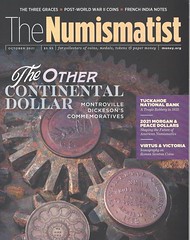 It's not clear that the ANA member who wrote about the photo even asked that it be removed. Pointing it out is important. Education is the key. Even though I was aware of the topic from an earlier E-Sylum article, the coin in the October Numismatist looked like an ordinary Hobo nickel to me - just another man wearing a hat. I'm afraid I wouldn't have thought twice about using it either. The letter and response were very helpful. Removing the image, not so much. Luckily I had my hardcopy issue handy so I could check and learn what the discussion was about. Thank you.
-Editor
It's not clear that the ANA member who wrote about the photo even asked that it be removed. Pointing it out is important. Education is the key. Even though I was aware of the topic from an earlier E-Sylum article, the coin in the October Numismatist looked like an ordinary Hobo nickel to me - just another man wearing a hat. I'm afraid I wouldn't have thought twice about using it either. The letter and response were very helpful. Removing the image, not so much. Luckily I had my hardcopy issue handy so I could check and learn what the discussion was about. Thank you.
-Editor
Brad Karoleff writes:
"While I wholeheartedly agree with the (normally) perfect George Kolbe about the needless censorship of the ANA I would like to point out my disagreement with the remaining 1%.
"I would refer to his comment about Hitler appearing on coins. If I remember correctly, the dictator appeared on numerous medals and Notgeld and innumerable stamps but never on a circulating coin. Strange but true.
"We, as numismatists, are caretakers of history, not censors. Should we then destroy all the offending items of history? How many ancient coins would be consigned to the melting pot or just never to see their images used again in modern publications? To the fires of censorship go Caliguila, Stalin, Victoria and Jefferson. All who have offended, participated in genocide or slavery.
"While I do not condone their actions I understand them in the context of the history in which they lived. We should learn from their actions so that their mistakes, or atrocities, should never be inflicted upon humanity ever again.
"Now, back to our normally scheduled program of enjoying numismatics……."
For more information, see Ben Weiss' article:
ANTISEMITIC BIGOTRY ON HISTORIC MEDALS
(https://www.amuseum.org/anti-semitism/)
To read the earlier E-Sylum article, see:
NOTES FROM E-SYLUM READERS: DECEMBER 5, 2021 : On Purging the Numismatic Record
(https://www.coinbooks.org/v24/esylum_v24n49a09.html)
More on Dr. Henry D. Cogswell
Dave Lange writes:
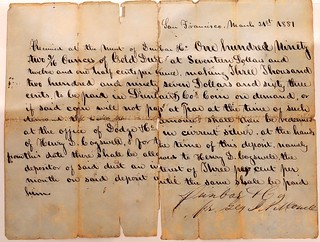 "I was intrigued by the Dunbar & Co. receipt letter for a gold deposit made by Henry D. Cogswell. Dr. Cogswell (he was a dentist) is a name familiar to me from an article I researched and wrote 40 years ago.
"I was intrigued by the Dunbar & Co. receipt letter for a gold deposit made by Henry D. Cogswell. Dr. Cogswell (he was a dentist) is a name familiar to me from an article I researched and wrote 40 years ago.
"Cogswell attributed his success in life to clean living and the avoidance of alcohol, so he used much of his fortune installing public drinking fountains throughout the United States. One of these stands in San Francisco's Washington Square Park, and it's topped by a statue of Dr. Cogswell. On the centennial of its installation in 1979, a time capsule was retrieved from the base of the fountain and its contents revealed. Among its treasure and trash were numerous medals and coins, the latter including worn pieces from circulation as well as freshly struck examples from the San Francisco Mint. I examined the numismatic items in person at the California Historical Society during 1981 and wrote an article and inventory for the Pacific Coast Numismatic Society. This was later published in the Summer 1984 issue of Calcoin News. An expanded version, including my own photographs, was published in the January 1985 issue of The Numismatist.
"I know I still have my photos somewhere, but I can't quite find them in a timely manner to share here. Nevertheless, the Calcoin News article is accessible at the NNP, and The Numismatist is available to all ANA members at its digital archive."
Interesting. Thanks! -Editor
To read the earlier E-Sylum article, see:
MINT LETTER OF DUNBAR GOLD DEPOSIT
(https://www.coinbooks.org/v24/esylum_v24n49a22.html)
Slab Lab
James Sibley of
Spring, TX writes:
"Thanks for mentioning Slab Lab in the latest E-Sylum. What a great way to learn about some of the major players in this great hobby/industry of ours! The 3-part episode with Jim Halperin was fascinating, as I consider Heritage to be of one of the great success stories of today's numismatics. Only thing is... I think I would have taken the $22 million Jim was offered for New England Rare Coin Galleries when he was in his mid-twenties."
It's a great series, and a new one with Jimmy Hayes has just been posted. -Editor
To read the earlier E-Sylum article, see:
VIDEO: PCGS SLAB LAB
(https://www.coinbooks.org/v24/esylum_v24n49a15.html)
Query: Elephant with Umbrella on Gambling Token?
Ted Puls writes:
"How about a new "What is It" coin. This elephant with an umbrella above was with a neat collection of Thai gambling tokens, And one 18th century Burmese (Myanmar) coin. Three sizes 18, 20, 22 mm, and this one with possible character on the base. The height (about 10 mm thick) of the elephant makes the picture hard to take. The surface has green and white highlights suggesting some copper and some lead content."
Can anyone help? Click on the images to see higher resolution version on our Flickr archive. -Editor
Ted Buttrey's Son Sam on Jeopardy!
Julia Casey writes:
"I watched Jeopardy! Wednesday and a man named Sam Buttrey was one of the contestants. I immediately thought of Ted Buttrey and then when they did the contestant interview he mentioned his father was an expert in Mexican coins! He won and will move on in the Professor's Tournament!"
Julia did some online searching to confirm that Sam is the fourth of Ted Buttrey's four children. Ted was instrumental in calling attention to the problem of false Western gold bars on the numismatic market and faced off against Mike Hodder in the famous "Great Debate" on the topic. He spent the last part of his career in the numismatic department of the Fitzwilliam museum in Cambridge, England, where I visited him in 2007. -Editor
To read the complete articles, see:
Naval Postgraduate School associate professor to make ‘Jeopardy' debut
(https://www.montereyherald.com/2021/11/29/naval-postgraduate-school-associate-professor-to-make-jeopardy-debut/)
In memoriam Ted Buttrey (1929-2018)
(https://tenthmedieval.wordpress.com/2018/01/21/in-memoriam-ted-buttrey-1929-2017/)
Rod Eric Bates (1960-2021)
Jeffrey S Zarit passed along this obituary of Rod Eric Bates, a dealer from Port Isabel Texas. Thanks. -Editor
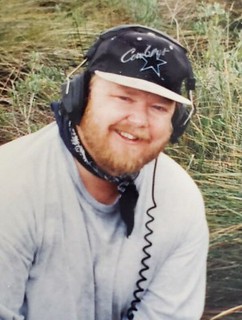 Rod Eric Bates, 61, passed away Tuesday October 12, 2021 surrounded by his loving family.
Rod Eric Bates, 61, passed away Tuesday October 12, 2021 surrounded by his loving family.
He was born in Rockford, Illinois in 1960, and has resided in the Rio Grande Valley since 1968. He has one daughter, Amber. He was the owner of Rio Bravo Gallery in Port Isabel where he shared his passions of treasure hunting, antiques, and local history. He was a historian and storyteller with a drive to share his knowledge with those around him - a frequent guest speaker and a prolific author with several local history books and numerous articles. Rod was also an avid metal detectorist who spent countless hours researching and hunting for artifacts from the American Civil War and Mexican-American War.
To read the complete article, see:
Rod Eric Bates
(https://www.tributearchive.com/obituaries/22691445/rod-eric-bates)
Old Book Smell
For bibliophiles, Chriss Hoffman passed along this Free Range cartoon from November 11, 2021. Thanks! -Editor
To read the cartoon online, see:
https://www.creators.com/read/free-range/11/21/310647
VOCABULARY TERM: GOLD MEDAL
Here's another entry from Dick Johnson's Encyclopedia of Coin and Medal Terminology. -Editor
Gold Medal. A medallic item made of gold, often as an award – usually the highest in rank – and infrequently that highest ranking award, but not necessarily made of gold.
Such quasi gold medals usually bear an inscription calling itself a gold medal (Olympic, exposition and medals awarded in quantity fall in this category). There is no requirement to identify the metal components on the medal itself, unless, of course, the item does indeed have some gold in the composition.
Early gold medals were hallmarked; 20th century gold medals would be edgelettered with a karat number (unless it was made by a national mint which do not abide by the legal requirements applied to private makers). But the first test of a gold medal is its apparent weight, it should be heavier than any similar medal of the same size. More exact information would be revealed by a specific gravity test – this could determine the fact the item is gold and even the exact karat content. Of last resort (but all too often performed) should be the test cut to observe if the item bleeds a different color proving it was one that was goldplated (rather than solid gold).
Nonaward gold medals were made as early as the Renaissance, goldsmiths were the makers of these. Often these were embellished with jewels and more often an ornamental object than a medallic item. Benvenuto Cellini (1500-1571) was the first goldsmith, medallist and engraver who made coins (scudo of Alessandro de'Medici), medals (Pope Clement VII, Pietro Bembo), seals (for Ercole Gonzaga, Cardinal Ipoolito d'Este) in addition to gold ornamental objects (his saltceller of Francis I is most famous).
The ownership of gold medals places a responsibility upon the owner to protect them, as gold medals are subject to melting during unsettled times. Only a small number of any originally issued survive. (The survival ratio of gold medals is as low as that of gold coins.) Thus the gold bullion medal, created during the last quarter of the 20th century provides the investment media, where this function was provided by gold coins and medals in the past. Gold bullion medals can be melted without any cultural loss experienced when gold medals (particularly if they are inscribed are melted.
To read the complete entry on the Newman Numismatic Portal, see:
Gold Medal
(https://nnp.wustl.edu/library/dictionarydetail/516000)
MORE ABOUT ROBERT H. LLOYD
Michael Kodysz submitted this nice article with more information about Robert H. Lloyd, the longest-standing member of the American Numismatic Association. Thank you! -Editor
Thank you for publishing the interesting biography of Robert H. Lloyd, who lived to be 103 and holds the record for the longest ANA membership of 83 years. Based on what I gathered from this and the linked article about Robert L. Hendershot, it seems that the three people who were members of the ANA the longest are:
83 years - Robert H. Lloyd (1906–2009)
82 years - Eric P. Newman (1911–2017)
74 years - Robert L. Hendershot (1898–2005)
This prompted a number of questions: is there anyone between Newman's 82 years and Hendershot's 74 years? Also, which currently-living person has been an ANA member the longest? Thinking it might be Q. David Bowers, I searched the online archives of The Numismatist and found his application for membership announced in the February 1956 issue. This is nearly 66 years ago. If Mr. Bowers is the currently-living person with the longest ANA membership, would this place him fourth on the list of all-time longest members?
Mr. Lloyd was born in 1906, but according to the E-Sylum article his father died in 1881. I wondered whether this error had been copied from Mr. Lloyd's obituary published in the March 2010 issue of The Numismatist, but I found no reference to his parents there. Since his obituary says that he served as an ANA governor and also on the Convention Advisory Board, this led me to another question: had Mr. Lloyd ever exhibited his collection of bank notes at an ANA convention?
Searching the archives further I found my answer. The Numismatist of October 1934 reports that Robert H. Lloyd of North Tonawanda, New York, exhibited the following items at the ANA convention that year: large-size notes of Western New York banks; large-size notes with low numbers; rare transportation tokens.
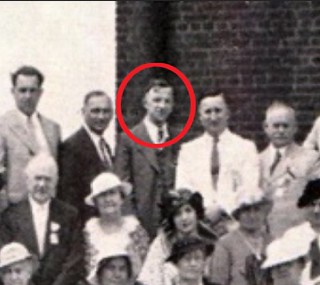 Published in this same issue is a fold-out photograph showing convention attendees on the roof of the Carter Hotel in Cleveland, Ohio, the location of the 1934 convention. The next page lists the names of the people in the photograph, and Mr. Lloyd's name is the seventh in the fourth row. As I looked for Mr. Lloyd in the photograph I found it hard to ascertain who actually belongs to the fourth row and thus who counts as the seventh person. But basing my visual identification of him on the images published in the E-Sylum article, I think I have him identified correctly in the photograph and have included a copy of it with his face circled in red.
Published in this same issue is a fold-out photograph showing convention attendees on the roof of the Carter Hotel in Cleveland, Ohio, the location of the 1934 convention. The next page lists the names of the people in the photograph, and Mr. Lloyd's name is the seventh in the fourth row. As I looked for Mr. Lloyd in the photograph I found it hard to ascertain who actually belongs to the fourth row and thus who counts as the seventh person. But basing my visual identification of him on the images published in the E-Sylum article, I think I have him identified correctly in the photograph and have included a copy of it with his face circled in red.
As a native Clevelander and current resident of the area, my curiosity was again piqued: where was the Carter Hotel located and does it still exist? I found out that the building once known as the Carter Hotel, which opened in 1917 on Prospect Avenue near East 9th Street, is still there. Originally named Hotel Winton after the Cleveland-based Winton automobile manufacturer, it is now an apartment building named Carter Manor. I found it interesting that the ANA held the entire convention inside of the hotel rather than at the more spacious Cleveland Public Auditorium, which at the time of its opening in 1922 was the largest convention hall in the United States. But this is a testament to the modest scale of ANA conventions back then.
Since the convention photograph with Mr. Lloyd had been taken on the hotel's roof, in the background can be seen the tops of other buildings. Curious to know if I could identify the group's exact location on the roof, I used Google Earth to zoom into the building and rotated my view to find it. This method enabled me to locate the brick wall with a double-hung window that formed the backdrop for the group shot. The wall looks curved in the photograph due to distortion caused by the wide-angle camera lens. The building seen behind it in the photograph with a turret-like structure on top is Halle building, which is now occupied by apartments. At the time of the photograph it was called the Pope Building and housed the Halle Bros. department store.
Pete Smith answers some of these questions in his article for this week. -Editor
Pete adds:
"I have a great respect for Michael Kodysz as a two-time winner of the Howland Wood Memorial Award for best-of-show exhibit at an ANA convention. (2019 and 2021). Now I have additional respect for his research on the 1934 ANA convention. I hope he continues to contribute interesting items to The E-Sylum.
Yes, he caught an error in my article on Robert H. Lloyd. Morris Dempster Lloyd died in 1944."
To read the earlier E-Sylum article, see:
ROBERT HEPWORTH LLOYD (1906-2009)
(https://www.coinbooks.org/v24/esylum_v24n49a13.html)

A.N.A. 75-YEAR MEMBERS
American Numismatic Biographies author Pete Smith submitted this article on 75-Year Members of the American Numismatic Association. Thanks! -Editor
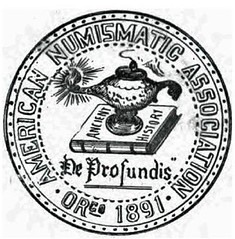 The ANA created the 75-Year Membership Award in 2000 in anticipation that Robert Hepworth Lloyd would qualify in 2001.
The ANA created the 75-Year Membership Award in 2000 in anticipation that Robert Hepworth Lloyd would qualify in 2001.
Robert H. Lloyd joined the ANA in 1926 as member 3024. He was honored as a 75-Year Member in August 2001. He died at age 103 and had been an ANA member for 83 years, holding the record for longest ANA member.
Wallace T. Miller joined the ANA in 1932 as member 1004096. His 75-Year membership was announced in the July 2007 issue of The Numismatist and his death was noted in the October 2007 issue. The 1930 Census shows his year of birth as 1907. The Numismatist carried seven change of address notifications from 1932 to 1943. He returned from military service to work at the First National Bank in Warsaw, Indiana. I believe this was Wallace Thomas Miller, Sr., born on June 9, 1906, and died on December 14, 1984. Interesting that the ANA didn't discover this when they gave him the 60-year award in 1992.
Ray. E. Carter joined the ANA in 1932 as member 1004120. His 75-Year Membership was published in July 2007 and his death was noted in the August 2007 issue. When he joined, his address was St. Anthony, Idaho. Ray Ervin Carter was born in St. Anthony, Idaho, on October 14, 1908, and died there on May 25, 1986, at age 77. I suspect someone in the family maintained his membership after his death.
Eric P. Newman joined the ANA in 1935 as member 4624. He was honored in 2010. His death occurred in 2017 after 82 years as an ANA member. This is the second longest tenure after Robert Lloyd.
Lawrence H. Meyer was honored as a 75-Year member in 2010. He had been honored as a 50-Year Member in 1985 as member 4643 indicating that he joined the ANA in 1935. However, member 4643 was shown as William Holtzman in 1935. The name of William Holtzman appears in The Numismatist twenty times from 1930 to 1956. The name of Lawrence H. Meyer appears only three times without an address. There is probably a story there but I am not the one to tell it.
Harry B. Solmson, Jr. joined the ANA in 1935 as member 4710. He was honored as a 75-Year member in August 2010. His death was noted in the issue of September 2010. He served as a lieutenant during World War II and returned to go into the drug business, rising to the position as president of Plough, Inc. before consolidation into Schering Plough Corp. He was born on March 31, 1911, and died on August 4, 2006. He is buried at Memphis Tennessee.
Raymond Moulton joined the ANA in 1935 as member 4817. He was honored in 2010. He was an ANA district secretary for Nebraska. He was born on April 22, 1907, and died on April 19, 1999, and is buried at Omaha, Nebraska.
Carl G. Boehmer joined the ANA in 1936 as member 5422. He was honored as a 75-Year Member in July 2011. Canadian Carl Graham Boehmer was born on May 8, 1906, and died on June 8, 2011. He is buried at Kitchener, Ontario. He passed the 75-Year mark but died before he could receive the award. His name can be added to the elite group of 100-year-old numismatists.
Philip Weinberg joined the ANA in 1939 as member 7471. His 75-Year Membership was published in July 2014. A person who appears to fit was Philip Weinberg born on August 19, 1903, and died on November 11, 1997. He is buried at Owings Mills. Maryland.
David M. Kemp joined the ANA in 1939 as member 7579. His 75-Year Membership was published in July 2014. He served in the Navy during World War II. When he joined, his address was in Frederick, Maryland. David M. Kemp of Frederick was born on March 22, 1907, and died on May 24, 1999 with 60 years of ANA membership.
George Y. Suzuki joined the ANA in 1939 as member 7794. He was honored in 2015. The 1930 Census lists him born in 1907 and the manager of a jewelry store. Another George Suzuki joined the ANA in 1969. I can't confirm the death of the original member but suspect he was not still living at age 108 in 2015.
Lee Hornbeck joined the ANA in 1942 as junior member 1009259. He was honored as a 75-Year Member in August 2017. A death notice was published in September 2021. I believe this was Lean (Lea) Hornbeck, born on August 17, 1925, and died on June 3, 2020. That would give him 78 years of membership and place him third on the list for length of membership.
Although these twelve were honored with 75-Year Membership, it is possible that only four of them actually lived long enough to deserve it. Perhaps the ANA should make a greater effort to confirm a member is still living before honoring him with a longevity award.
To read the earlier E-Sylum article, see:
ROBERT HEPWORTH LLOYD (1906-2009)
(https://www.coinbooks.org/v24/esylum_v24n49a13.html)

FIVE QUESTIONS WITH KENNY SAMMUT
The October 2021 issue of The Clarion from the Pennsylvania Association of Numismatists included an article titled "Five Questions Answered By Kenny Sammut." With permission, we're republishing it here. Thanks to editor Rich Jewell for forwarding this. -Editor
Five Questions Answered by Kenny Sammut
1. When and why did you become a coin collector?
 Back in 2007, my father purchased some of the newly released
Presidential Dollars. I immediately took an interest to them and
started to flip through the Red Book. Although at my age (I
was only 5 or 6), I only truly understood values and dollar signs,
however over time I grew to appreciate their history and designs.
After a while, I decided to branch out into world coins. I started
to skim the phone book sized Krause catalogues and fell in love
with the beautiful designs. And over the years, I have branched
out even further and now I know a little bit about exonumia
and numismatic literature.
Back in 2007, my father purchased some of the newly released
Presidential Dollars. I immediately took an interest to them and
started to flip through the Red Book. Although at my age (I
was only 5 or 6), I only truly understood values and dollar signs,
however over time I grew to appreciate their history and designs.
After a while, I decided to branch out into world coins. I started
to skim the phone book sized Krause catalogues and fell in love
with the beautiful designs. And over the years, I have branched
out even further and now I know a little bit about exonumia
and numismatic literature.
2. What are you currently collecting?
My main focus is on world coins. I do not focus on any country in particular; instead,
I purchase whatever catches my eye. Historical context also plays a big role in what I
purchase as I love connecting stories with my collection. A sub-collection
of mine
includes presidential campaign tokens, medals, and pins as they are rich in history.
3. What one thing has coin collecting taught you that you might have
never learned otherwise?
Numismatics has taught me numerous business techniques. Along with my collecting,
I run a numismatic eBay store where I sell world coins, US coins, tokens, medals, other
exonumia, numismatic literature, and more.
4. Who has been most helpful in your personal coin collecting journey?
I have been fortunate over the years to have many numismatic mentors. A local coin
dealer, George Mavrelos, owner of Pennies, Pounds, and Pesos in Media, Pennsylvania,
has taught me so much since I was a fledgling coin collector. You can pick up any
coin in his shop and he would tell you what was happening in that country at the time
the coin was minted as well as interesting stories about the coin itself. I have learned
so much history from him. Should I open up my own store someday, I would hope
to be as interesting as Mr. George. Mrs. Pam and Mr. Dave Stitlely have also played a
monumental part in my numismatic upbringing by supporting my love for the hobby
and to help me become more involved with the local clubs and associations. They are
committed to introducing and helping YNs get excited about the hobby as they know
these children will become the future of our hobby.
And I can't go without mentioning Ken Bressett. I have been fortunate to attend the ANA Summer Seminar since I was 13. The ANA has a wonderful scholarship program and this is how I met Mr. Ken. He is so giving of his time and his excitement about collecting is very contagious. As I have gotten older, he and I have spent more time together during the seminar. I would love to accomplish one tenth of what he has. He is amazing.
5. You're the ANA President, name one thing you would do to make
coin collecting more attractive to young people?
If I were the ANA president, I would have the ANA along with the US Mint and some
younger actors, who are popular with children, create videos showing the many
benefits and fun young people can have collecting coins. Benefits include learning history, math, politics, and geography as well as helping them with their reading and
organizational skills.
Additionally, there is a story behind just about every coin. These stories can be told in a way a child will understand and will hopefully make the coin so much more than a coin. The younger child may not even realize he/she is learning about history, geography, and all of the other educational benefits. The older child will and for some they will become avid collectors and may even do better in history. Parents will appreciate that and hopefully support the child's new interest in coins.
As kids are visual and want to do cool
things, the young actors will be a key in helping
children see coin collecting as something they should try. Contests and rewards can
be set up by the ANA and the US Mint. Parents can be given ideas on having their own
contests and rewards for their children or grandchildren.
These videos might get children talking about coins and if the contests were fun and achievable it may generate some friendly competition amongst friends and turn enough of them into long term avid collectors so our hobby will continue and grow for many years to come.
Some background information:
- ANA LM
- PAN Member
- FUN Member
- Member of 5 local clubs along with several other clubs in the US along with a number of International Clubs and Societies
- 2019 ANA Young Numismatist of the Year
- Active on social media for the past seven years promoting numismatics
- Owner of a successful numismatic store on eBay for the past two years
- Offered an Internship with NGC this summer
For more information about the Pennsylvania Association of Numismatists, see:
https://pancoins.org/
HOLABIRD DECEMBER 2021 SALE
Here is the press release for the December 2021 Holabird Western Americana sale. Great variety of material! -Editor
HOLABIRD WESTERN AMERICANA COLLECTIONS, LLC WILL HOLD A DECEMBER DREAMS: PREMIER AMERICANA AUCTION, LIVE AND ONLINE, DECEMBER 17th -19th
The auction has more than 1,900 lots in a wide array of collecting categories and at price points that will appeal to both novices and veteran collectors alike. Important collections will be sold.
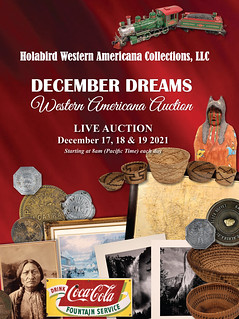 Holabird Western Americana Collections, LLC is famous for its five-day auctions
featuring thousands of highly collectible items in a rainbow of categories, but the firm will end
2021 with a tidy, three-day affair, December 17th -19th , online and in the Reno gallery, boasting
over 1,900 lots of rare books, art, mining, numismatics, stock certificates, postcards and more.
Holabird Western Americana Collections, LLC is famous for its five-day auctions
featuring thousands of highly collectible items in a rainbow of categories, but the firm will end
2021 with a tidy, three-day affair, December 17th -19th , online and in the Reno gallery, boasting
over 1,900 lots of rare books, art, mining, numismatics, stock certificates, postcards and more.
The December Dreams: Premier Americana Auction will begin at 8 am Pacific time all three days. Highlighted collections include more parts of the Ken Prag postcard collection, the Bill McIver token and medal collection, the MacKenzie Montana collection and the Ron Lerch Western collection. These will be supplemented by world-class rarities from other collections.
Day 1 will contain over 600 lots of philatelic (stamps); military, political and firearms; gaming collectibles; and model railroad and toys. Postcards, many of them from the Ken Prag collection, will include California (especially wine country), Hawaii, Disney, Titanic and Pioneer examples. The gaming section includes items from the Shirley Bovis Cowboy Museum in Tombstone, Ariz.
Of the 500 postcard lots from the Ken Prag collection, about 350 lots are California-related, but 40 lots or so are Hawaii-themed. Lot 1361 – nearly 80 early Hawaii and South Seas Curio Co. postcards, including cards from the Aloha Nui series – has an estimate of $300-$600; while lot 1447, a group of ten Titanic-related postcards from around the time of the tragedy, should realize $700-$1,500.
A highlight of items from the Shirley Bovis Cowboy Museum is lot 1552, a circa 1880-1890s well-used holster that appears to have been made for a medium-framed revolver with a Buntline length barrel (estimate: $800-$1,600). No maker's mark is visible, and it would be difficult to place ownership of the rare holster, but good guesses are lawmen Wyatt Earp and Bat Masterson.
Tops in the firearms category is lot 1551: a model 1888 Gewehr 88 rifle (aka a commission rifle) made at the Amberg, Germany arsenal in 1891, in very good condition with bluing on the barrel sleeve and magazine well (estimate: $800-$1,000). A must-have for original European weapons collectors, the rifle has a Mauser-inspired design but the Mauser arsenal didn't design this model.
Day 2, December 18, has 683 lots of books (featuring Part 1 of the Ron Leach Western directory
collection; mining artifacts and ephemera; and stock certificates and bonds, to include mining
and railroad. There are about 200 directories from this first installment of the Ron Lerch collection. Directories are considered a primary source
material and, as such, are essential
aspects of historical research.
Two key pieces from the Lerch collection are the Wells Fargo & Co. Express Directory of Chinese Houses (all in California) from 1878, one of the most sought-after of all the Western directories; and a Montana Territory History & Business Directory from 1879, when Montana was not yet a state, 218 pages, with original fold-out map. Both have estimates of $3,000-$6,000.
Other Day 2 highlights include a handbill issued by Wells Fargo in 1866, extolling the thefts of company monies used by several agents to gamble on mining stocks (estimate: $2,000-$4,000); and a Britton & Rey lithograph depicting life scenes of gold miners in the 19th century, titled Bar Room in the Mines and Long Tom, one of only five known copies (estimate: $ 1,000-$2,000).
From the Joe Elcano mining stock collection is a certificate for the Grosch Consolidated Gold & Silver Mining Company (Virginia City, Nev.), for one share, issued to Benjamin Nickerson, issued on Dec. 31, 1864, signed by the company president and secretary, showing two vignettes: a bare-chested allegorical woman and a gold prospector on the move (estimate: $1,200-$2,000). The certificate is important because the company was a scam market play on the original Comstock discoverers, the Grosch Brothers.
Day 2 lots 2455-2514 are Nevada mining stocks; the majority are from the massive Elcano collection. This is the first one of multiple sales that will feature the Elcano Nevada mining stock collection. The entire Day 2 mining section is strong, though, and features some really great California Gold Rush material (to include letter-sheets), a huge Colorado section, and Montana and Nevada.
The auction's final day, December 19th , promises to be a busy one, with 614 lots of Native Americana, art (featuring Ansel Adams, Salvador Dali, Thomas Kincaide, Japanese art and more), numismatics (including coins and currency, medals and so-called dollars), tokens (featuring Part 2 of the Bill McIvor Nevada token collection), and general Americana.
As always, there will be a strong Native American section, featuring baskets (with more to come in the next sale), jewelry and art. Artwork will include three early Salvador Dali signed lithographic prints and a wonderful group of Japanese woodblocks and prints, many signed.
Antiquarian photography is a key category for collectors. Day 3 will feature historic and possibly unique Western stereo-view cards and photographs, led by a fabulous Ansel Adams original photograph group from his Yosemite Series (all signed), including Moon and Half Dome (1960), print No. 10, considered one of Mr. Adams's greatest photographs (estimate: $10,000-$20,000).
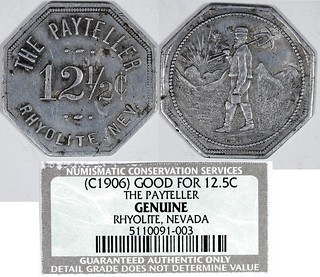 Offerings from the Bill McIver Nevada token and medal collection are not to be missed. They
include the centerpiece of his collection: possibly the finest known 12.5-cent token from The
Payteller (Rhyolite, Nev.), showing a bearded miner with a pick, shovel and lunch bucket, plus a
mountain and rising sun (estimate: $7,000-$10,000), octagonal in shape and 30mm in width.
Offerings from the Bill McIver Nevada token and medal collection are not to be missed. They
include the centerpiece of his collection: possibly the finest known 12.5-cent token from The
Payteller (Rhyolite, Nev.), showing a bearded miner with a pick, shovel and lunch bucket, plus a
mountain and rising sun (estimate: $7,000-$10,000), octagonal in shape and 30mm in width.
The MacKenzie Montana collection continues with historical documents and ephemera. A spectacular and large artisan pot by Montana artist Randall Blaze (b. 1949), 17 inches tall, is expected to bring $4,000-$8,000. The pot is from an exhibition titled Shields by Randall Blaze, Oct. 16-Dec. 11, 1988, at the Museum of the Plains Indian and Craft Center in Browning, Mont.
A great numismatic rarity is found in a letter of 1851. Prior to the establishment of a Branch US
Mint in California, private firms made their own gold coins. Some came under fire in 1851 for
not containing sufficient gold. These firms, including Dunbar & Co., were attacked
in the local
press, which adversely affected their value. Directly reacting to this adversity, a letter here
addresses how Dunbar would cure and defect. It is the first original document found to date to
discuss this important period.
The letter is signed by Dunbar & Co. and dated March 31, 1851, noting the receipt of 192 9/16 ounces of gold dust at $17.125 per ounce to be paid in Dunbar & Co.'s (gold) coin on demand, "or if said coin will not pay at par at the time of such demand, the amount shall be redeemed at the office of Dodge & Co. in current silver at the hands of Henry D. Cogswell, should rise to $3,000-$7,000.
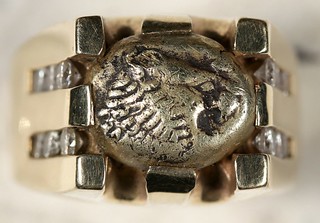 A numismatic treasure is lot 3389: a 6th century BC ring of one troy ounce of solid 14kt gold,
carefully holding a 1/3 stater gold piece with a lion motif (estimate: $7,000-$8,500). The ring has
12 diamonds, six on either side in rows of two, with a combined weight of 0.84ct. It is one of the
world's first gold coins, is in great XF+ condition and comes with a certificate of authenticity.
A numismatic treasure is lot 3389: a 6th century BC ring of one troy ounce of solid 14kt gold,
carefully holding a 1/3 stater gold piece with a lion motif (estimate: $7,000-$8,500). The ring has
12 diamonds, six on either side in rows of two, with a combined weight of 0.84ct. It is one of the
world's first gold coins, is in great XF+ condition and comes with a certificate of authenticity.
Online bidding via iCollector.com, LiveAuctioneers.com, Invaluable.com and Auctionzip.com. The full catalog can be viewed online now, at www.holabirdamericana.com. For those planning to attend the auction in person, regulations and protocols regarding COVID-19 will be enforced.
Color catalogs are available by calling 1-844-492-2766, or 775-851-1859. Also, anyone owning a collection that might fit into an upcoming Holabird Western Americana Collections auction is encouraged to get in touch. The firm travels extensively throughout the U.S., to see and pick up collections. The company has agents all over America and will travel to inspect most collections.
Holabird Western Americana Collections, LLC is always seeking new and major collections to bring to market. It prides itself as being a major source for selling Americana at the best prices obtainable, having sold more than any other similar company in the past decade alone. The firm will have its entire sales database online soon, at no cost – nearly 200,000 lots sold since 2014.
To consign a single piece or a collection, you may call Fred Holabird at 775-851-1859 or 844- 492-2766; or, you can send an e-mail to fredholabird@gmail.com. To learn more about Holabird Western Americana Collections, LLC and the December Dreams: Premier Americana scheduled for December 17th through 19th , please visit www.holabirdamericana.com. Updates posted often.

WORLD BANKNOTE AUCTIONS LIVE SALE 19
And here is the press release for World Banknote Auctions Live Sale 19. -Editor
This week World Banknote Auctions launched Live Sale 19, which takes place in two parts on December 22 and 23, with live bidding starting both days at 10 AM PST. As usual, live bidding will take place on the website and on the mobile apps of World Banknote Auctions. Combined, the sale features a total of 722 lots from around the world.
The first part of Live Sale 19 on December 22 features the Kabul Collection of Afghanistan. This advanced collection of Afghanistan features notes from the very first issue to modern issues, and is virtually complete by design type. Highlights include high grade examples of scarce types, and a large number of specimens. This is truly one of the more advanced collections of Afghanistan to come to the market in recent years
says Dennis Hengeveld, President of World Banknote Auctions. The collection was put together over several decades by an advanced collector from Europe, and while quality varies, the completeness of the collection is unprecedented
.
The second part of Live Sale 19 on December 23rd features a varied selection from around the world, ranging from the 19th century to modern polymer issues in high grade. As always, Live Sale 19 features a low 15% buyer's premium ($5 minimum) and flat-rate shipping costs via Fedex: $10 within the United States and $25 to the rest of the world. Registration is free of charge and payment is possible via credit card, wire transfer, or check.
Lot 19061 is a PCGS Banknote graded Choice About Uncirculated 58 example of the 500 Afghanis of the 1939 (SH1318) issue, identified as Pick-27. A grand note in both size and denomination, this is one of the classic key notes for the country. It is problem-free with good eye-appeal, and carries a pre-auction estimate of $2,000-$2,500.
Lot 19087 is the highest denomination of the 1948 / SH1327 series, the 1000 Afghanis (Pick-36) graded Gem Uncirculated 65 PPQ by PCGS banknote. Representing a large amount of money at the time of issue, this has become a very difficult note to locate in Gem Uncirculated condition. It carries a pre-auction estimate of $1,250-$1,500.
Lot 19295 is the single finest PMG-graded example of the 10 Francs of the 1905 Danish West Indies series (Pick-18a). Graded Choice Very Fine 35 by PMG and one of just eleven issued examples in the PMG population report, the 10 Francs is a classic banknote from what is now the US Virgin Islands, appealing to both US and World collectors alike. The United States purchased the islands from Denmark in 1917 and most of these were quickly redeemed. This rarity features a pre-auction estimate of $6,500-$7,500.
Lot 19496 is a major signature rarity for the French Colonial specialist. This 5 Francs from Martinique (Pick-6A) graded About Uncirculated 55 by PMG features the Alizard-Bonneville signature combination and features a pedigree back to the Michael Becuwe collection, which was sold in 2007. This is the first signature combination for this type and it is extremely rare, featuring a pre-auction estimate of $2,000-$2,500.
Lot 19567 is an extremely rare specimen of a 1924 2 1/2 Rupias from Portuguese India, Pick-24s, graded Uncirculated 62 by PMG (Previously Mounted). An extremely difficult type to find in both issued and specimen form, there have been no appearances at public auction of this type since at least 2016. It features an impressive vignette of a tiger on the front and is one of the classic notes from European Colonial India. This classic rarity carries a pre-auction estimate of $5,000-$6,000.
Lots 19631 – 19632 – 19633 are a very interesting and rare trio of notes from the Bank in St. Gallen in Switzerland. Dating back to the late 1830s, these were printed by the firm of Draper, Toppan, Longacre & Co., who had their offices in Philadelphia and New York. In appearance similar to many obsolete U.S. banknotes printed by the firm, these are extremely rare and seldom offered. The trio are all remainders, but according to a specialized Swiss catalog no issued examples are known. The trio each carry a pre-auction estimate of $1,000-$1,250.
Lot 19682 is the only specimen/proof of the famous 1930 commemorative issue from Uruguay we have been able to find a record of. This 1 Peso is graded About Uncirculated 55 by PMG (with a comment for stains
) the grading service called this Pick-17s. While that is technically correct, there are some minor differences in the text on the front that truly make this an uncorrected proof or specimen. Possibly unique and highly unusual, this rarity carries a pre-auction estimate of $2,000-$2,500.
To read the complete article, see:
World Banknote Auctions Presents Live Sale 19
(https://www.worldbanknoteauctions.com/news/world-banknote-auctions-presents-live-sale-19/)
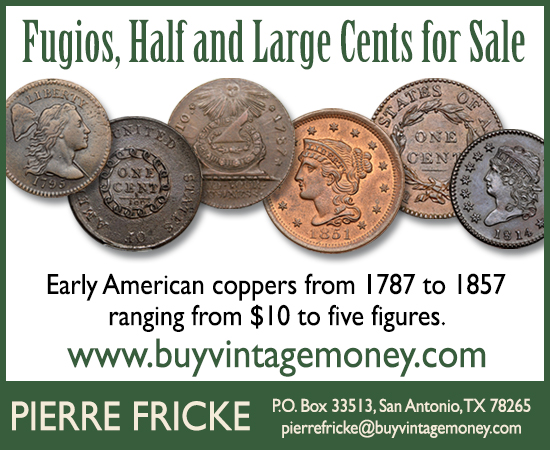
CANADIAN NUMISMATIC CO. JANUARY 2022 SALE
Here's the press release for the Canadian Numismatic Company January 2022 sale. -Editor
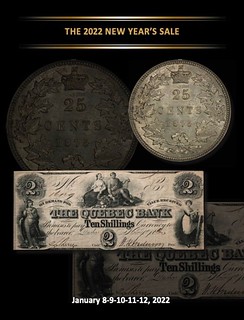 Welcome to The 2022 New Year's Auction sale event. This auction of more than 1600 numismatic lots features three major collections joined by selections from 75 other consignors across North America. The first and second Sessions are highlighted by three attractive coin and banknote collections.
The
Welcome to The 2022 New Year's Auction sale event. This auction of more than 1600 numismatic lots features three major collections joined by selections from 75 other consignors across North America. The first and second Sessions are highlighted by three attractive coin and banknote collections.
The Little Collection
Part III of Canadian Copper, The MacFadyen Collection
of Militaria and Canadian banknotes, The Gem Collection
of Canadian banknotes and coins.
Also featuring in this auction; an elusive 1888 50 cents in Mint State-63. An ultra rare 1875H 25 cents in Mint State-62, a fantastic and original roll of 1935 silver dollars, a very scarce 1913c-Sovereign in Choice Mint State-64. A beautiful 1917 50 cents in Gem Mint State-66, a stunning 1932 50 cents in Specimen-64.
Several top graded banknotes from The Gem collection
are included in sessions 2 and 5. A unique Eastern Townships $1 dated 1859, the finest 1908 40 cents Newfoundland cash note, a rare $4 dated 1871 from The Bank of Liverpool, a wonderful Proof example of the 1935 $500 english text series. A good assortment of tokens is listed in session 3. In addition, a superb selection of very scarce Proof and Specimen banknotes and several others including Rare Serial number issues and error notes.
Again, The Little
Collection Part III holds a premium selection of carefully chosen elusive copper issues. Most of the coins are graded by ICCS and each piece has been carefully selected and is attractive and proper for the grade attributed, some surprises and attractive issues. The MacFadyen Collection
offers an outstanding selection of Militaria medals, decorations and banknotes, the two Jewels of this collection are a Quebec Bank $2 dated 1860 and a $5 Proof from The Province of Canada dated 1866.
Both are Unique and excessively rare.
Several other attractive and stunning issues. This fantastic New Year's Auction sale event should make some spectacular moments and active evenings of auctioning. We expect this to be one of the prestigious numismatic online events of 2022 featuring several rarities never offered to the public.
Our sincere thanks to the consignors for entrusting us with the fantastic task of selling their collections. We hope you enjoy this catalogue as much as we enjoyed making it. This should be a memorable sale! Happy and Prosperous New Year!
To view the auction lots online, see:
https://auctions.canadiancoinsandpapermoney.com/auction/180/the-2022-new-years-sale-major-event
To view the .pdf catalog, see:
https://www.canadiancoinsandpapermoney.com/wp-content/uploads/2021/12/TCNC-2022-New-Years-Sale-LR.pdf
2022 NYINC SALE HIGHLIGHTS
Here's a press release of some highlights of the January 2022 New York International Numismatic Convention sale. -Editor
January 2022 will welcome the return of the New York International Numismatic Convention after its cancellation last year, to the delight of the numismatic market as a whole. One auction that always stands out from the many sales taking place during the convention is the New York Sale, a collaboration between Sovereign Rarities, Goldberg Coins, Dmitry Markov and M&M Numismatics. 2022's New York Sale will take place between the 11-13 January and includes a trio of superb catalogues; one will be dedicated to Russian coins and medals, another to Ancient coins, and the last to World coins.
The highlight of the strong selection of gold and silver ancients on offer may certainly be the Tetradrachm of Cleopatra and Mark Antony struck in 36 BC. This coin symbolises the famous union of two of the ancient world's most prominent historical figures and is perpetually popular with followers of the classical numismatic series.The New York Sale's world catalogue features offerings from over 40 countries. Early in the auction is a run of high-grade and rare Anglo-Gallic pieces, including a gold Noble Guyennois à l'E or Pavillon d'Or of Edward the Black Prince struck between 1362-72. This rarity is tied for the finest graded of the type, being certified by NGC as MS64.
As always, the British section boasts some of the most select pieces of the entire sale; it begins with a run of hammered silver and gold, but it is in the milled section that we see some truly marvellous coins. A prooflike Five Guineas of William and Mary, dated 1692 and graded by NGC as MS61+ dominates the early milled section, closely followed by two exceptionally high-graded Two Guinea pieces of George I. The first of these, dated 1738, is graded as MS63, whilst the second is the single finest certified specimen, dated 1748 and graded as MS64.
The reign of George IV is particularly well-represented in this sale, with an 1826 gold proof Five Pounds, Two Pounds and Sovereign on offer; the first is graded as PF61 Cameo, while the second and third are superbly graded as PF64 Ultra Cameo. These ever-popular proofs are seen sporadically at auction, but the sale also includes a far rarer proof offering of this monarch: an 1825 proof pattern Sovereign, extremely rare and graded by NGC as PF63 Cameo. This elusive type has an opening bid of $20,000.
The historic British section leads into a group of British modern gold coins, including some perfect- graded rarities; notably, the sale includes a 2009 gold proof Kew Gardens 50 Pence, the most popular of the 50 Pence series and the first to be publicly offered graded as PF70 Ultra Cameo.
The same is true of the 2004 Entente Cordiale gold proof Five Pounds in the auction, also the first to be offered in a PF70 Ultra Cameo holder. These are just some examples of the strong modern British section of the sale, and collectors of this increasingly popular area are encouraged to consult the catalogue for the full range.
After the conclusion of the British material on offer, we see a fantastic and extensive group of Italian coins, including several rare Papal medals and a very rare pattern 5 Lire of 1857. The World coins continue with rarities such as a South African ‘Veld' Pond of 1902 struck during battle in the Second Boer War, graded by NGC as AU58. Finally, the auction concludes with an extremely rare Hungarian Taler of 1672, struck in Beszterce. One of very few examples known, this prize of the Taler series carries a starting bid of $25,000. The sale promises to be extremely popular as always, and we wish our bidders the best of luck for the auction.
THE BOOK BAZARRE
NUMISMATIC NUGGETS: DECEMBER 12, 2021
Here's a selection of interesting or unusual items I came across in the marketplace this week. Tell us what you think of some of these. -Editor
Kushan Empire, Vima Kadphises (c.113-127), gold Double Dinar, 15.99g, bilingual series, Bactria, king enthroned facing with bearded head left, he sits on a low cushioned throne with ornamental legs, his feet on a footstool, wearing a tall round cap with upturned peak, diadem ribbons to right, flames emerge from his right shoulder, he wears an open robe with double clasp, trousers fastened in similar manner, and heavy padded boots, he holds a branch in his raised right hand, his left hand concealed in sleeve of jacket rests on his left thigh, a heavy club in left field, tamgha in right field, Greek legend around starting at 1 o'clock: baiey ooh - mo ka?Fh(King Wima Kadphises), rev. Oesho stands facing, head to left, flames emanating from top of head, ithyphallic and naked except for a diaphanous garment, amulet string across chest, he holds a trident in his right hand, an animal skin in left, he leans against a bull standing right, nandipada symbol in left field, Kharoshthi legend around: maharajasa rajadirajasa sarvaloga isvarasa mahisvarasa vima kathpisasa tradara (of great king, king of kings, lord of the world, great lord, Vima Kadphises, saviour) (Göbl 11; Jongeward & Cribb 260; Sunrise 523), some surface flecks, good extremely fine, rare
From the Spink auction of Ancient, Indian and Islamic Coins closing on 16 December 2021. -Editor
To read the complete lot description, see:
KUSHAN EMPIRE, VIMA KADPHISES (C.113-127), GOLD DOUBLE DINAR, 15.99G, BILINGUAL SERIES, BACTRIA...
(https://live.spink.com/lots/view/4-4FP1BC/kushan-empire-vima-kadphises-c113-127-gold-double-dinar-1599g-bilingual-series-bactria)
Sikh Empire, Ranjit Singh (VS 1856-96; 1799-1839), Nanakshahi Rupee, Amritsar, 11.1g, VS 1882 (1825), with downward-pointing katar or dagger on obverse, and groups of beads on both obverse and reverse (Herrli 01.07.04; Gurprit Singh 01.48.01, KM 20.1), small natural flan fault at top of obverse and unobtrusive test punch either side, attractively toned good very fine and extremely rare, if not unique (Tikkanen 529)
Gurprit Singh notes that at the time of writing only one coin of VS1881 featuring a dagger had come to light. If this is still the case then the three in this auction must increase the known dagger types dramatically. All are struck from different dies to the coin he illustrates, and also from each other. He does not list a coin of this type of VS1882.
Another beautiful coin from the December 16, 2021 Spink sale. -Editor
To read the complete lot description, see:
SIKH EMPIRE, RANJIT SINGH (VS 1856-96; 1799-1839), NANAKSHAHI RUPEE, AMRITSAR, 11.1G, VS 1882 (...
(https://live.spink.com/lots/view/4-4FP47E/sikh-empire-ranjit-singh-vs-1856-96-1799-1839-nanakshahi-rupee-amritsar-111g-vs-1882-)
Charles II (1660-85), Two Guineas, 1664, elephant below pointed truncation, first laureate bust right, toothed borders both sides, legend surrounds CAROLVS II DEI GRATIA. Rev, crowned cruciform shields, emblematic sceptres in angles, interlocking royal monogram at centre in the form of connected C's, five strings to Irish harp, date flanking top crown, reads MAG BR FRA ET HIB REX (S.3334; Schneider 430; EGC 204; MCE 32). Well struck on good gold, some hairlines and light metal stress fissures. The portrait well detailed with the normal fade in the central region of King's hair. Rev, mirrored with some flashes of original mint bloom. Good very fine for issue.
The Elephant provenance emblem below the bust helped highlight the coins exclusively issued by the Royal African Company, this was an English mercantile trading company founded in 1660 by Prince Rupert in unison with the City of London merchants. It was originally known as the Company of Royal Adventurers trading into Africa. It had its initial aim or focus in and around the vicinity of the West Coast of Africa, with an especial focus on the lucrative Gold available around the Gambia river, in fact it had been granted a monopoly over English trade around the West coast of Africa. By 1672 it had been relaunched as the Royal Africa company of England. Insolvent by 1708, it continued to trade with reduced activity up until 1750, at this point it's assets and commodities were transferred to new African Company of Merchants which lasted until 1821.
Great coin offered by Baldwin's. -Editor
To read the complete item description, see:
CHARLES II (1660-85), TWO GUINEAS, 1664, ELEPHANT BELOW
(https://www.baldwin.co.uk/product/charles-ii-1660-85-two-guineas-1664-elephant-below/)
1863 CIVIL WAR TOKEN CWT STORECARD - BROAS BROTHERS - HEAVILY CLASHED DIES
A very unusual error on a Civil War token. Interesting piece! -Editor
To read the complete lot description, see:
1863 CIVIL WAR TOKEN CWT STORECARD - BROAS BROTHERS -
(https://www.liveauctioneers.com/item/118669051_1863-civil-war-token-cwt-storecard-broas-brothers)
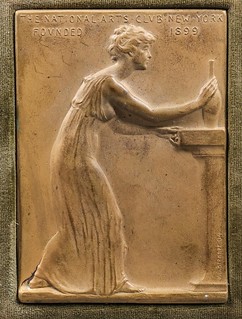 Victor Brenner (American, 1871-1924) bronze plaque "The National Arts Club, New York, Founded 1899", gilt bronze in felt frame, signed "V. D. Brenner '04", plaque measures 4-1/8" x 3", framed 7" x 5-7/8", good condition
Victor Brenner (American, 1871-1924) bronze plaque "The National Arts Club, New York, Founded 1899", gilt bronze in felt frame, signed "V. D. Brenner '04", plaque measures 4-1/8" x 3", framed 7" x 5-7/8", good condition
A nice Brenner plaque I hadn't seen before. -Editor
To read the complete lot description, see:
Lot 80600: Victor Brenner (American, 1871-1924) bronze plaque "The National Arts Club, New York, Founded 1899", gilt bronze in felt frame, sign...
(https://www.invaluable.com/auction-lot/Victor-Brenner-American,-1871-1924-bronze-plaqu-80600-c-B7346EFA4A)

KELLOGG AND CO. $20 COIN HOARD
In his Stack's Bowers blog Dave Bowers has been covering the topic of coin finds. This week he published an article about an interesting find of pioneer gold coins. -Editor
In August of 1908, two boys named James McFarland and John May were swimming in the Little Blue River in Thayer County, Nebraska. While resting on a small sandbar near the limestone bluff, John May kicked up a gold coin. It turned out to be a Kellogg and Co. $20 coin minted in San Francisco during the Gold Rush. John, an orphan who lived in Belvidere, was able to rake two more coins from the sand near the bluff.
John lived with a man named Spaulding who confiscated the coins and demanded to know where they were found. According to the Hebron Journal, the boys refused to tell Spaulding and returned to the bluff the next day. James McFarland found a small hole near the old mouth of the cave and retrieved a sack containing $1,100 in Kellogg $20 gold coins. (These 1854 and 1855 minted coins apparently had been hidden by William Abernathy, a former California miner who returned to Nebraska to take up ranching and who was killed by the Pawnee in August 1867.)
Evidently, the seemingly heartless Spaulding, who was not John May's legal guardian, kept John's three Kellogg coins. The whereabouts of the coins are unknown today.
Reports indicate that the remaining $1,100 in Kellogg $20 coins was deposited into a bank in Geneva, Nebraska. The coins were received as a cash deposit, so tracing them has become quite difficult.
The site of the find was destroyed years ago for safety reasons. The limestone bluff is fragile, and residents feared a cave-in.
Much is left to be discovered. What happened to the 58 $20 coins? How were they dispersed, and who has them now? Or were they melted years ago? The beauty of research and the enjoyment of numismatics often come not from the actual acquisition of a coin or a bit of information, but from what occurs during the search for discovery. It is through the search that we learn, grow, and share. The contemplation today of an actual specimen of an 1854 or 1855 Kellogg & Co. $20 gold piece becomes all the more interesting when one considers the coin's history—how it was minted and what its later experiences may have been.
To read the complete article, see:
A Remarkable Find
(https://www.stacksbowers.com/News/Pages/Blogs.aspx?ArticleID=gold-coins-and-a-remarkable-find)
To read the earlier E-Sylum article, see:
PIGGYBANK FULL OF 1826 LARGE CENTS
(https://www.coinbooks.org/v24/esylum_v24n48a29.html)

GEORGE OHR'S PROVOCATIVE CLAY TOKENS
The November-December 2021 issue of The TAMS Journal from the Token and Medal Society has a fascinating article by Ellen Lippert about the pottery of George Orr. At my request editor Greg Burns kindly forwarded text and images for this excerpt of the article, republished here with permission. Thank you! -Editor
The pottery of George Ohr is captivating. Deformed and manipulated shapes that sag and bulge are often coated in vibrant glazes that bubble, run, or ooze. Their lopsided statures and crumpling physiques possess an irreverent liveliness made all the more apparent when placed alongside the stoic Greek and Chinese pottery forms that were popular during Ohr's time. Mirroring these unique wares is the potter himself, whose personality and life story is just as vibrant, irreverent, and, now, legendary.
Existing within his famed oeuvre are lesser studied objects often termed trinkets
. Among these are a small collection of six clay tokens bearing crude and highly sexualized messages made of letters, numbers, and images. Despite their provocative nature and famous maker they remain almost completely unstudied. This article will trace Ohr's history as a potter, businessman, and self-promoter during the last quarter of the nineteenth century in order to provide a better context from which to examine his provocative collection of six clay tokens.
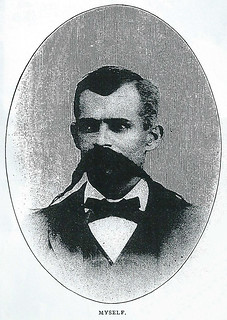 George Ohr was a potter from Biloxi, MS, who lived from 1856 to 1918. Much of the information we know about Ohr comes from his brief two-page 1901 autobiography titled
George Ohr was a potter from Biloxi, MS, who lived from 1856 to 1918. Much of the information we know about Ohr comes from his brief two-page 1901 autobiography titled Some Facts in the History of a Unique Personality
in which he lays out his life from birth until the year 1883. From the start Ohr presents himself as different, labeling himself the lone duck
of the family, despite having four siblings.
Throughout his early years Ohr struggled to find his calling and purpose, bouncing between jobs that never lasted long and didn't suit him. However, in 1880 Ohr received a letter from family friend and well-known potter Joseph Meyer offering to teach him the potting trade in New Orleans. After receiving Meyer's invitation Ohr states he stole a freight train at 11:65, and p.d.q went under the night and over terra firma.
According to Ohr, when he found the potter's wheel I felt it all over like a wild duck in water
and from that moment on dedicated his life to making pottery.
In 1908, at the age of 52, Ohr stopped producing work. With money he received from an inheritance, Ohr bought a car dealership and went into business with his sons. He boxed up his wares and tucked them away in the attic of the dealership.
This is where his pottery remained for half a century until New Jersey antiques dealer James Carpenter discovered his trove in the 1960s. He bought the entire collection, rumored to be between 6,000 and 10,000 pots and launched Ohr onto New York's art world stage. Since then Ohr's pottery has enjoyed much more critical and popular attention. His wares routinely fetch multiple thousands of dollars at auction, some as much as $100,000 and more. No less than seven books (including my own) and scores of articles have been written on Ohr in the last few decades and the Metropolitan Museum of Art recently acquired a significant collection of Ohr's pots from noted ceramics collector Robert Ellison who died in 2021. Ohr's pots have even been collected by well-known artists like Andy Warhol and Jasper Johns, who used them in several of his artworks. Indeed, over the past sixty years Ohr has emerged as a major figure in American art.
Ohr's story is one of legend: the misunderstood potter dedicated to his craft gives up in frustration only to have his wares discovered and posthumously praised and valued.
The entirety of Ohr's token collection consists of six double-sided clay coins bearing pictures, words, and numbers combined to form twelve messages, all crudely sexual. Some coins have ridged perimeters while others are smooth, suggesting at least two different casts.
Very little is known about these tokens. None of the coins are signed or dated, which was Ohr's custom for much of his art pottery. There is no information on how they were distributed: were they sold or handed out? In sets or individually? Further there is no definitive information about when Ohr started making them or how many are even in existence, though prominent Ohr collector, the late Marty Shack, has stated [b]esides the sixty odd sets I bought from the family I would doubt if another twenty sets survived. This approximation would put the number of individual coins made somewhere between 360 and 480. Ohr's tokens can still be collected, but a complete set doesn't fetch anywhere near as much as a highly collectable art pot though prices for Ohr's tokens have been increasing.
It is unknown (and unlikely) that Ohr ever made much money from his coins. There is no record that they were purchased as his art pottery was purchased. However, like a business card handed out at a convention, Ohr's coins associated the frenzied mustached potter, and thus his wares, with the fantasy of Storyville and suggests that Ohr's tokens were yet another means of promotion that Ohr perceptively utilized.
For more information about the Token and Medal Society, see:
https://www.tokenandmedal.org/

FRANCES OUTERBRIDGE SUFFRAGETTE MEDAL
This Antiques Trade Gazette article discusses a 1912 silver suffragette hunger strike medal. -Editor
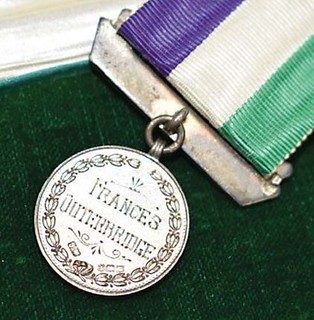 Stroud Auction Rooms recently received a 1912 hunger strike medal engraved with the name Frances Outerbridge and the date March 1, 1912.
Stroud Auction Rooms recently received a 1912 hunger strike medal engraved with the name Frances Outerbridge and the date March 1, 1912.
The accompanying case has a typical gilt inscription Presented to Frances Outerbridge by the Women's Social & Political Union in recognition of a gallant action, whereby through endurance to the last extremity of hunger and hardship, a great principle of political justice was vindicated.
Frances Outerbridge, a nurse born in Cardiff in 1847, does not appear in any Suffragette records but it seems she used her mother's maiden name Williams when arrested. A Frances Williams is mentioned in press cuttings following a window smashing on March 1, 1912 and in subsequent court records at the London Bow St Sessions. ‘Williams' was believed to have been imprisoned and went on hunger strike.
Outerbridge lived in Bow with fellow hunger striker Caroline Lowder Downing who was arrested on numerous occasions including on March 1, 1912.
However, it seems her interest in the cause of women's suffrage may have come from further afield. Her uncle was Bermudan businessman and political figure Thaddeus Outerbridge who at the behest of his daughter, Anna Maria Outerbridge, petitioned the Bermudian parliament for suffrage in 1895-96. Although the bill was passed in the house of assembly, it was defeated in the legislative council and the women of Bermuda had to wait until 1944 for the right to vote.
Stroud Auction Rooms (soon to be Harper Field) will offer the medal, case, hair lock and lorgnettes on January 12-13 with an estimate of £2000-5000.
To read the complete article, see:
Hunger strike medal reveals story of Suffragette with a pseudonym
(https://www.antiquestradegazette.com/print-edition/2021/december/2520/news/hunger-strike-medal-reveals-story-of-suffragette-with-a-pseudonym/)
A number of suffragette hunger strike medals have come to market in recent years. Below are links to some earlier E-Sylum articles. -Editor
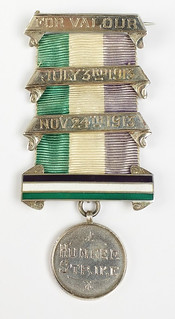 To read the earlier E-Sylum articles, see:
To read the earlier E-Sylum articles, see:
A SUFFRAGETTE SOCIETY MEDAL
(https://www.coinbooks.org/esylum_v18n10a27.html)
1912 WOMEN'S HUNGER STRIKE MEDAL
(https://www.coinbooks.org/v21/esylum_v21n06a35.html)
1912 SUFFRAGETTE HUNGER STRIKE MEDAL
(https://www.coinbooks.org/v21/esylum_v21n43a22.html)
SELINA MARTIN SUFFRAGETTE HUNGER STRIKE MEDAL
(https://www.coinbooks.org/v22/esylum_v22n13a27.html)
KATE EVANS 1912 SUFFRAGETTE HUNGER STRIKE MEDAL
(https://www.coinbooks.org/v23/esylum_v23n03a09.html)
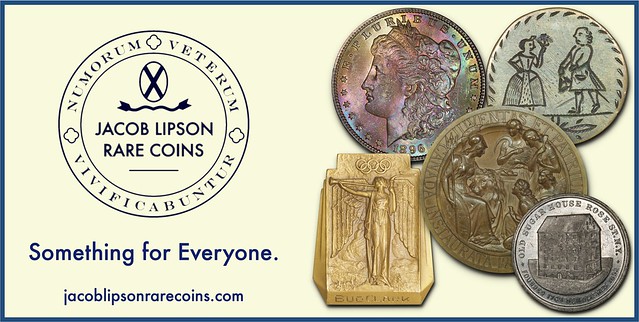
PHILIPPINE 1000 PISO NOTE CORRECTED
The forthcoming new 1000 Piso note from the Philippines has been corrected after a mistake was called out on social media. -Editor
The Bangko Sentral ng Pilipinas (BSP) said Sunday it has corrected the spelling and formatting of the Philippine eagle's scientific name seen on the circulated photo of what it said was a sample of the new P1,000 banknote.
"The BSP clarifies that the recently circulated photo of the new banknote was of a sample previously sent to the BSP for review," it said in a statement.
"Necessary corrections have already been made, including the spelling and italicizing of the scientific name of the Philippine eagle," it added.
The central bank made the statement after some social media users, including Bayan Muna Rep. Carlos Zarate, pointed out errors in the new design of the P1,000 banknote.
In a series of Twitter posts, Zarate said the Philippine eagle's scientific name — Pithecophaga jefferyi — was misspelled as "Pithecophega jefforyi."
Zarate said the eagle's scientific name should have also been italicized "because it is in Latin and needs to be differentiated from the English."
"This is one of the rules in the proper writing of scientific names," Zarate said, adding that the BSP made "almost the same mistake in 2010."
The new design of the bill features the Philippine eagle in the front, replacing World War 2 heroes Jose Abad Santos, Vicente Lim and Josefa Llanes Escoda. It is scheduled for circulation in April 2022.
To read the complete article, see:
BSP says 'necessary corrections' made on new P1,000 banknote
(https://news.abs-cbn.com/business/12/12/21/corrections-made-on-new-p1000-banknote-bsp)
FAKE SCOTLAND TWENTY ‘POOND' NOTE
In the you-just-can't-make-this-stuff-up department, here's a tale from Scotland of counterfeit currency and a lack of quality control. -Editor
A dad who bought games consoles with counterfeit cash after his family's benefits were cut was caught out because the dodgy notes were in poonds
not pounds
.
But eagle-eyed sellers spotted that the false banknotes read ‘Twenty Poonds' instead of ‘Twenty Pounds'.
Inverness Sheriff Court heard Melville, 27, had arranged to buy PlayStation consoles worth £430 from two different advertisers through online selling site Gumtree last year.
Fiscal depute Ruaridh Allison said: The accused met each of the parties by arrangement on September 7, at which time a price had been agreed on.
Handing over the money, notes used in the transaction were found to be counterfeit.
Melville, of Granish Way, Aviemore was charged with two counts of fraud and one of possessing items of counterfeit currency with the intent to pass or tender them as genuine or deliver them to another.
Melville was not present when the case called but solicitor Josey Donachie pled guilty on his behalf.
She added that he had chosen to buy the consoles from online sellers to sell on for real cash to use in shops because: The counterfeit money was of such poor quality it would not be accepted.
To read the complete article, see:
Spelling mistake rumbles dad's fake twenty ‘poond' cash con
(https://www.pressandjournal.co.uk/fp/news/crime-courts/3743511/spelling-mistake-rumbles-dads-fake-twenty-poond-cash-con/)

A BECHTLER HERITAGE CENTER CHRISTMAS
The Bechtler House in Rutherfordton, NC held a Christmas event this week. This place should be a destination for every American numismatist. -Editor
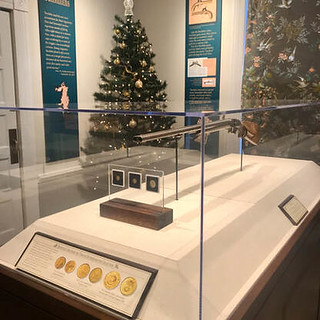 December 4th was no doubt going to be a warm sunny day but some of the towns folk and out-of-town visitors were pondering about how a cold, frosty Christmassy day would be perfectly matched to the charm of the Bechtler home with rooms all aglow, blended into a German celebration….Western North Carolina style of course. All of the ingredients for a delightful and nostalgic afternoon were thoroughly mixed and enjoyed by all who entered.
December 4th was no doubt going to be a warm sunny day but some of the towns folk and out-of-town visitors were pondering about how a cold, frosty Christmassy day would be perfectly matched to the charm of the Bechtler home with rooms all aglow, blended into a German celebration….Western North Carolina style of course. All of the ingredients for a delightful and nostalgic afternoon were thoroughly mixed and enjoyed by all who entered.
One by one, guests moved from room to room, amidst simple but elegantly decorated trees, wreaths and fireplace mantels, totally engrossed in the history behind the exhibits, and the story of the North Carolina Gold Rush. Exhibits included the original Coin Press designed and used by Bechtler to mint over $2 million dollars in gold coins, one coin at a time. The press is on loan from the American Numismatic Society in New York. One of two known Bechtler Rifles in existence is prominently on display and music lovers admired Bechtler's 1840s square grand piano.
Children were immersed in learning about the gold history of the area alongside their parents and grandparents as they watched the Bechtler Gold documentary. On display was the largest collection of Bechtler coins — The Norman Jenkins Collection. Betty Jenkins graciously exhibited the collection for this event.
Christopher Bechtler minted America's first one-dollar gold coin, 17 years before the U.S. Mint. The Bechtlers minted more than $2.24 million dollars in gold coins, stimulating commerce in the Southeast leaving a permanent legacy to both Rutherford County and American history.
To read the complete article, see:
Bechtler Heritage Center celebrates Christmas with open house
(https://www.thedigitalcourier.com/news/bechtler-heritage-center-celebrates-christmas-with-open-house/article_54d2e236-5081-5f5f-892d-7b01b08ffa32.html)
For more information on the Bechtler Heritage Center, see:
NORTH CAROLINA GOLD TRAIL & BECHTLER HERITAGE CENTER
(https://www.visitncgold.com/)
Bechtler House Heritage Center
(https://www.visitncgold.com/rutherford.html)

FEATURED WEB SITE: MONEY TECH BLOG
This week's Featured Web Site is the Money Tech Blog from Noll Historical Consulting. Found via News & Notes from the Society of paper Money Collectors (Volume VII, Number 25, December 7, 2021).
News and Views on the Technology of Money: Past, Present, and Future
https://www.franklinnoll.com/blog

